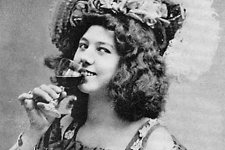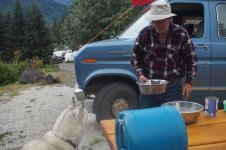Thanks for the suggestion regarding the ash, Canotrouge. I wasn't around when it happened, so I don't really know. But the link I just added below the image is to a site on what's up yukon web page that says it occurred in 800 AD. Perhaps there have been many such eruptions.
-
Happy Marine Mammal Rescue Day! 🐳🐬🦭🦦
You are using an out of date browser. It may not display this or other websites correctly.
You should upgrade or use an alternative browser.
You should upgrade or use an alternative browser.
Yukon River 2019
- Thread starter PaddlingPitt
- Start date
Another great write up Michael! Really enjoying this. My buddy Hal was on his way to Dawson? I think when he said the worst headwind he's ever encounter was roaring up the river and his reputation is for headwinds, we call him Headwind Hal! Looking forward to the next part of the journey!
dougd
dougd
dougd, Was HeadwindHal on the Yukon River when that hellacious headwind sprang up?
I suspect that you weren’t surprised that Shadow was doing just fine in the dog hotel. We were very relieved, though.
I suspect that you weren’t surprised that Shadow was doing just fine in the dog hotel. We were very relieved, though.
Gee we were at Coal Mine in 2013 and it was for sale then! But very nice inside eating place when it poured.. And a bike of questionable ancestry/repair that did get us to the grocery.
Questers and diapers. I have raced the YRQ 3 times (and the 1000 mile race twice). i have heard about the diaper method, and believe that some (particularly women) use that method, but none in my voyageur teams. As bow paddler, i am cautioned not to turn around when the women behind me are using their various relief contraptions. From their comments, I don't think they work very well. It takes about 20 hours of continuous paddling to reach our mandatory 7 hour rest at Carmacks, where our pit crews prepare meals and quiet time beds for us. I have been lucky enough to have either an RV or rented a cabin with a real bed each time through. i could talk about paddling the Yukon all day long. Such an experience. One of these days I would very much like to paddle the Yukon in "tourist mode", leisurely enough to take photos of what I can only briefly glimpse as we pass by during the races. My greatest memories involve losing count of something greater than 30 eagles before reaching Policeman's Point and Lake Laberge. Then on the lake, the wide variety of weather conditions, from surfing large trailing waves to stormy headwinds. On one trip the lake treated us to three distinct stormy weather pattern conditions interspersed with calm during our 7 hour passage through the length of the lake. Finally back into the current of the 30 mile, we return to reading surface current for fastest speed. A lateral shift of just one canoe length may gain us as much as 2mph. I loved learning to read with subtle changes in the surface could tell me. Approaching islands, as much as a half mile upriver you could see currents begin to diverge. Get over to the planned side quickly. else be swept to the wrong side and take and extra a mile of distance and too much time. Sharp cliffs at water's edge tend to mean deep water and faster current. Watch for potential pre-planned shortcuts at river bends. A lot of water going into the shortcut channel is good, but if the channel widens out much before rejoining the main river channel, you could be in dead water with little or no helping speed. The clear bluish water of the 30 mile ends where the murky coffee colored Teslin River joins at Hootalinqua. The river becomes opaque here at race time of year. I wish we could have had time to stop for a visit at the shipwreck, but no go for racers. In 2009, we had fast current during the Y1K and most shortcuts were worth taking with lots of flow through. First night campsite was only a few miles beyond Hootalinqua, timing did not work out for visiting the shipwreck. At Carmacks on the YRQ we have to be sharply river right and ready to throw the bow line to waiting assistance at the dock. I have seen some paddlers who apparently fell asleep and missed the landing entirely. Their only hope of not DQing was to have someone catch them at the bridge. Seven hours later, to the exact minute we were paddling again, on our way to Five Finger Rapids. Watch for the huge back flowing eddy river right. paddle just to the outside of the eddy in down current. All paddles in the water as much as possible, bow paddler (me) brace to catch a soaking wash from going right through a standing wave, then a second later, my paddle could not even reach down to he water. Within 15 seconds it was all over. With hoots of delight we all wonder, "that was so much fun, can I do it again?". Rink rapids is next, stay far river right and it is smooth going as the water roars white over rocks to our left. Fort Selkirk, a watch point where race tracking officials with the YRQ record our canoe number and wave a hello as we sped on by. During the 1000 mile Y1K, there are no specific designated mandatory rest stops. Instead we are required to stop for 6 hours each "night" at any good looking place of our choosing along the river bank. According to the rules, stopped times must include the hours between 2315 and 0200 local, so we would start looking as the time approached 2230 each day. Strategy says don't stop too soon, lest your competition learn where you are an thus plan their next day's effort. During one Y1K, the timing of our arrival at Fort Selkirk happened to work out just right for us to camp there with real privies, fresh clean water, and smooth dry ground. Just beyond the fort, best current is center river and left, but at far river right (which we did the first time) offers "faces of the yukon", sharp rocky cliffs with imaginary faces where ever dark and light colored rocks happen to randomly appear to very tired sleep deprived paddlers just like cartoonish or grotesque faces and sometimes whole bodies. I spotted an entire image of Albert Einstein, complete with wing tipped shoes. Strangely, photos later tend not to show such detail. Some look like animals (there's a bison head with horns in one), Later, others look like lumberjacks with long flowing beards in the sandy hoodoo slopes. More islands, more current reading, more shortcuts to choose (or not). Coffee creek, the second mandatory rest stop on the YRQ (only). Just three hour this time. No pit crews, no cleaning of the canoe of food debris and other waste. Only mosquitoes under a large tarp next to other snoring paddlers. A sandwich and a cup of warm soup, with maybe a cookie is provided by the race organization. Difficult to sleep in a required 20 degree F sleeping bag carried with each of us. Too hot to fully zip up, too buggy to leave your head uncovered. Sleep fitfully, if at all. The white river soon joins the party. Aptly named, the river literally turns white with silt. You can hear the silt sanding the bottom to the canoe, sounds like mistuned AM radio static. Not far below, much of that silt shallows out the river as the Stewart river adds to it. No matter how careful you are, reading the shallow gravel shoals is too difficult to avoid them all. Only experience from a previous year's run can help a little, but not much since the river changes where the current best rushed each year. The final official race checkpoint is at the 60 mile river. Its all downhill from here, with many more decisions to be made in current. Dawson in sight, paddle tempo increases as spectators cheer each boat to finish the YRQ. Dawson is only a single point of interest on the Y1k as we sail on by. Barely half way finished now. pit crew may wave as they prepare to take the ferry to the Top of The World Highway and Alaska. Meanwhile, a few mile past Dawson on one YRQ,we stopped for a bio break where there happened to be a clean fresh water stream flowing down a mountainside. We all filled our bottles. Back underway one of the women noticed a flake of gold as she overturned her Nalgene bottle. I quickly hit my GPS to save the location. Later research did not find any mining data on that particular creek. We cross the international border into Alaska. Several miles later we are required to stop at Eagle, AK to show our passports to a waiting custom's agent, who was expecting us. Once Again, luck shined upon us during one of our YRQ races, as the timing worked out just right for our mandatory night's 6 hour rest camping spot at Eagle. In the spring of 2009, record spring floods and ice break up created ice dams down river. Islands were wiped clean of all trees. it looked as if a giant cheese grater scoured the river banks, ripping trees, root balls and all. Downriver from Eagle , great trees, roots and all became stuck , tops all pointing the way downstream, like sentinels in a graveyard of trees. Through the Yukon-Charlie National Preserve and on to the town of Circle, AK. The GPS map shows land where now only water now flows. 2230, camp on a damp muddy bit of remaining land. Thousands of islands and shoals to pick our way through in the Yukon Flats, always looking for best current to speed us along. Majestic fish wheels spin their greetings to us. Approaching one, a First nation's native speeds in a small craft toward us. I feared that we had intruded and were going to get told about it. Instead he held up his hand about 3 feet apart and said to us something like: "you want fish? king salmon". He had heard about the race and was offering us two free king salmon. Unfortunately we had to thank him and turn down the offer, as it was not practical to accept such an offer during the race. Our dining routine while still paddling with 6 in a voyageur canoe was to have one person (seat #5) stop paddling to boil water and fill our mugs with home dehydrated food (breakfasts and dinners), then pass them out as we all ate one at a time while all other continued paddling. For lunches we each snacked on our own. As team navigator i loved the challenge of route finding in the Flats and finding the fastest current. At one point we were being overtaken by a tandem canoe just as we arrived at a potential shortcut. I said, guys, we are going into that shortcut chute. The other canoe elected to stay in the main river channel, taking them an additional two miles further than us. We never saw them again until after the finish when they came in well after us. As we neared the finish line at the Dalton Bridge, we noticed small covered fishing skiffs on the river. Some were curious about us and just came to look. For our first YRQ in 2009, I can't begin to describe the emotions as the bridge finally came into view in the distance ahead. We had done it. Stay in current, then one last hard draw to the shore where our pit crew was ready to grab us. More side stories to remain private. A meal at the Yukon Camp restaurant, then a 4 hour drive to our hotel in Fairbanks. To be repeated again.
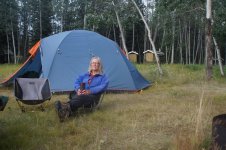
Thursday, July 4. Kathleen and I woke at six-thirty, and exchanged anniversary cards to celebrate our wedding of 38 years ago. After our breakfast bannock (cooked on a fire!) Kathleen strolled over to the St. Frances Xaviers Church to capture another image of its idyllic setting.
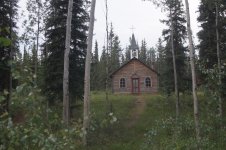
St. Frances Xaviers Church nestled in the trees, Fort Selkirk
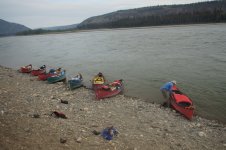
We broke camp quickly,and joined the Ruby Range Adventure group on the beach, as we all prepared to load and launch our canoes. I mentioned to Christine that Kathleen and I had been avoiding the strong headwinds by paddling down side channels.
“We don’t have the fast current, but it’s more pleasant.”
“I like paddling in the side channels,” Christine said. “It’s usually more scenic. But I don’t do that when I’m leading groups, which aren’t always able to stay close together, where I can see all of them at once.”
I held out my Carlyle paddle. “Say, Christine. I found this paddle above Five Finger Rapids. I don’t need or want it, though. Would you like to have it?”
“Sure. Thanks a lot.” She seemed genuinely pleased to have it.
Kathleen and I put on the water a little after nine-thirty, followed soon afterwards by the Ruby Range Adventurers. About 45 minutes later we heard Christine calling out. “Mike and Kathleen.”
We waited for her to catch up. She pulled alongside, and held out a black bag. “This was on the beach. It must be yours, as no one in my group claimed it.”
“No, it’s not ours. We saw it there when most of the gear was already loaded in the canoes. We assumed someone in your group would notice it as theirs.”
Christine’s group had now all caught up, and one of the Ruby Range Adventurers claimed their missing black bag. We appreciated Christine’s thoughtfulness.
During the next hour or so, Kathleen and I enjoyed paddling down side channels, in relatively calm weather. Around eleven, though, strong headwinds returned. dang! We stopped for lunch about noon, and watched the Ruby Range Adventurers pass by. We caught them a little before one o’clock, as they headed toward shore for their lunch, spinning and struggling against the wind. We never saw them again. We did, though, see seven Surf Scoters swimming in a comfortable group, all lined up, just like they were following Christine though Five Finger Rapids.
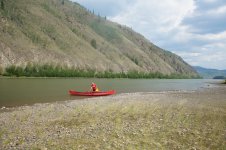
Not much happened the rest of the day. We just kept paddling into the wind, seeking respite in side channels. Occasionally we stopped on gravel bars to rest, and to wish for the wind to stop.
At around six o’clock we stopped at Issac Creek, which Rourke indicated was a “Good Camp.” The site had very steep access, and Kathleen didn’t even scramble up the bank to investigate. “I don’t like this, Michael. Too much work to lug our gear up there. We’d just be falling down. We can do better than this.”
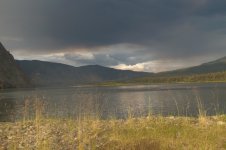
So we paddled over to a gravel bar. Very poor camping, and way too muddy for our liking. We then drifted two km (1 mile) down to “Sleepy Hollow Bar,” and found an acceptable place to pitch the tent. We moved in at seven o’clock, having covered 71 km (44 miles). This put us 15 km (nine miles) ahead of schedule.
We sat down on our low island, contentedly munching our daily allotment of gorp. Neither one of us was hungry enough for supper. We snacked on salami, cheese and crackers. The wind had stopped, and for the first time in days we could actually hear the Yukon River swirling and running around us. Low, black-and-white clouds filled the sky. A bit of smoke drifted down from the north, but the evening was truly calm. A beaver swam by, only five metres (five yards) away, and then slapped his tail before diving. We enjoyed the sun on our backs. Swallows darted and dove above the water. A gentle breeze drifted in from the west.
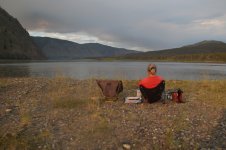
Kathleen revised our schedule while sitting on the beach. We now planned 65 km (40 miles) to Thistle Creek; 61 km (38 miles) to Rosebute Creek; 63 km (39 miles) to Baker Slough; and then only 26 km (16 miles) to Dawson, which would get us there one day early. Maybe I will try to catch a fish that last morning. I haven’t fished at all on this trip, as I generally fish only on layover days.
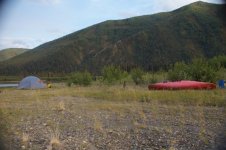
We headed to bed a little before ten-thirty. Gotta make time tomorrow. Kathleen poured two ounces each of Brandy. “Happy Anniversary, Michael. Not exactly the Hotel Vancouver like 38 years ago....”
Her voice trailed off. She didn’t elaborate on the dots, so I filled them in for her. “But we have a nice tent.”
“Yes, Michael, we have a nice tent.”
We sipped our celebratory brandy, as a blood-red sun, high in the smoky sky, peered through the vestibule window.
Friday, July 5. We rose early, ate our bannock and put on the water a little after nine. No time for puttering around camp. We needed to make distance.
A very calm, enjoyable morning. We were surrounded by silence, except for the soothing “dip, dip, dip” of our paddles reentering the water for another stroke. We pulled to shore for a break a little after eleven. With no head wind, we were averaging over 10 km (six miles) per hour, with very little effort. More or less just drifting along—riding the current down to Dawson City. Or, hopefully, at least to Thistle Creek today.
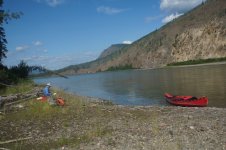
We stopped for lunch a little before noon, just downstream from Coffee Creek, the headquarters of Goldcorp, which plans to extract 2.4 billion dollars worth of gold over a ten-year period. We had heard that Goldcorp does not welcome drop-in visitors to their facilities, so had purposefully—and silently—sneaked right on by. Apparently we had not sneaked silently enough. Within minutes, a helicopter and a fixed wing aircraft flew very low overhead, as though conducting surveillance. Could have been mere coincidence, I suppose.
Back on the water, the headwinds returned, and we once again struggled to make progress. We paddled down a side channel to escape the strongest gusts, and saw what appeared, at first, to be a person standing on shore. The “person,” however, was actually a young moose. It stared at us, twitched a bit, then bolted around the bend to mother moose, who was feeding in the shallows next to shore. She didn’t seemed concerned by us, but we gave her a wide berth by crossing an open stretch of water against the wind.
In mid-afternoon, on the right bank, we saw a hand-written sign that read: Keep Right. Bakery & Campground App. 9 km. Rourke mentions this bakery/campground at Kirkman Creek. Do you remember the men, a father and son, two of our fellow passengers on the Husky Bus from Dawson City to Whitehorse? Well, they had stopped at the bakery for coffee and pie. Kathleen and I had been looking forward to the same pleasant interlude.
Strange, though, we thought, that they would post a sign so far away. Must be several mores signs along the way. We kept a sharp lookout. We wanted coffee and pie. We didn’t come across any more signs, but did see several groups of loons and mergansers. Often just one adult, surround by as many as ten, circling youngsters. Very cute.
Kathleen and I kept paddling directly into the wind, on the right bank, until we reached Kirkman Creek at five o’clock. We stopped at the first dock, and strolled up the bank to have a look. Only a couple of somewhat dilapidated buildings. Perhaps this was the bakery/campground, but no one seemed to be home, and we didn’t want to just snoop around. We paddled a short distance downstream to the second dock. I got out and walked up a short, dirt road with many parked vehicles. There were no people. There was no sign. There was no bakery. There was no campground. We would not be enjoying a pleasant interlude of coffee and pie.
More than a little disappointed, Kathleen and I resumed paddling downriver into the wind. Rourke did say “If no one is at the cabin, they’re probably out berry picking.”
About thirty minutes later we passed by a tent and an aluminum boat on a gravel bar. The wind had now become very strong, and we stopped at six, also on a gravel bar. We decided to camp, even though we were still about four km (2.5 miles) south of Thistle Creek, today’s destination. Pretty close—close enough. As we set up camp, dense, black smoke billowed over the ridge.
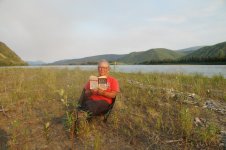
On Fridays, Kathleen and I almost always have some sort of seafood/pasta dish for supper. Today was Friday, and we dined on tuna casserole. The wind died and the sun appeared about nine-thirty. Kathleen sat out reading her free book that she picked up at the Innisfree Municipal Recreation Park. You remember that’s where we camped on our first night out from Preeceville. There was a selection of books just outside the campground office, with a sign that invited people to both leave, and to take books. If you took a book, the sign asked only that you take a picture of yourself reading the book, and then post the picture to their Facebook page. So that’s what Kathleen was doing.
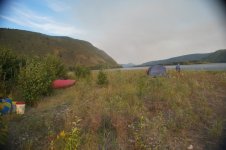
We were camped about 150 km (95 miles) from Dawson City. If the Questers can cover 715 km (443 miles) in three days, we should be able to paddle 150 km in two days, even without diapers and catheters. That was our plan now. We would get up early, have a granola bar, break camp quickly, and paddle in the anticipated early morning calm for as long as possible. To the tent for brandy.
Saturday, July 6. Up at 6:00 a.m. Granola bar for breakfast. Broke camp quickly. Calm conditions. On the water at 7:10 a.m. Got to make distance. Got to make 80-90 km (50-55 miles) today.
Fifteen minutes later we came across the pleasingly blue, two-tiered Amelia Lupine barge hugged up against the shore. The Canadian flag hung limply from the pole, which was good to see. Two guys stepped out onto the upper level. The shirtless guy called out, “Nice morning.”
“Yeah. we got an early start. When it’s still calm. Tired of all this wind.”
“Blowing directly at you.”
“Yeah. Six days straight.”
An hour later, we saw canoes and kayaks packing up way over on the right bank. “I think we gotta ferry over and say hello, Kathleen.”
“No we don’t. We got up early to make distance without the wind. Not to chat to strangers on the beach. They might not even want us to paddle over.”
Kathleen was right. We gotta cover distance. After two hours, I mentioned that “We’ll be coming to the White River soon, Kathleen.”
“Just a minute, Michael. Let me fill my water bottle. I hear the White has a lot of sediment.”
In fact, we had heard from several sources that the White River carried a lot of sediment. Do you remember the men, a father and son, two of our fellow passengers on the Husky Bus from Dawson City to Whitehorse? Well, they told us that the White River carried a lot of sediment. Sarah, the Husky Bus driver confirmed their observation, and said, “Most people let the water settle overnight. In the morning you have clear, drinkable water. And, in fact, the White River is so called because it’s white.”
We hadn’t fully absorb all this info information, though. Otherwise, we would have stopped to fill up our 20-litre water jug that we had brought for drinking water on Lake Laberge. But no, we didn’t do that. Silly us. After Kathleen filled her water bottle, we just paddled on. Only a few minutes later, we merged with the very white White River, which turned the Yukon River an opaque brown. Oh well. Too late now.
We soon paddled among numerous islands and log jams, all shrouded in dense smoke. It seemed like a 1930’s movie as we headed toward an unknown world, where the local population, dressed in nothing more than loin clothes, was terrorized by a Great Ape. A pair of Ravens called out their warning to us. Very eerie.
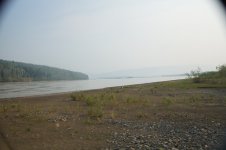
After three hours we stopped for a snack. Forty km (25 miles) covered so far. Pretty good. We’re making distance.
A short time later we stopped at the camp of the nervous dog people. You remember them from the Coal Mine Campground—four people, with one large, nervous dog, loading their tandem canoes. In my opinion, they paddled away very precariously, stroking tentatively, with the nervous dog jumping back and forth. At the time, I hoped they would make it through Five Finger Rapids. Well, apparently they had. Maybe I need to stop being so judgemental.
The dog still seemed nervous, and was obviously worried about Kathleen and me. Barked pretty much incessantly.
“How did your dog like being in the canoe?”
“He did pretty well. Jumped out only a couple of times. But he came through Five Finger Rapids just fine.”
“So, I’m curious. What do you do with him at night? Does he come into the tent with you?”
“No. We just let him wander around in camp. Don’t need to tie him at all.”
I was very impressed. If we did that with Shadow, he would certainly roam far and wide. We had read that Siberian huskies are true wanderers. Several articles had warned us that Siberian huskies should never be unleashed in unfenced areas. So we generally walked him three times a day on a 30-foot line. This gave him some freedom; but, he wanted to run. So, on the third walk of the day, just before his supper, we unleashed him 200 to 300 metres (yards) from home. He immediately burst into full speed, charging back to his house to wait for supper. It was beautiful to see. So strong and powerful, yet also so very graceful and elegant.
Every once in a while, though, Shadow ran off. Sometimes chasing a deer. Twice we saw him chasing a coyote—far off in the distance. Sometimes he ran off just for the sheer joy of running wild and free. During these events he usually disappeared for three to four hours, even at night. Although he always came back, we worried the whole time. So many dangers for him out there. Porcupines. Bears. Ranchers who said they shoot any dogs on their property, no questions asked. Would we unleash him in camp on the Yukon River? No way.
The nervous-dog-people all had English accents. One of the couples, though, lived in North Vancouver, British Columbia, in the mid-Lonsdale area, only about 15 minutes from where Kathleen and I had lived for 22 years. As they say, “small world.” I don’t really know who “they” are, but they say “small world.” Or so I’m told.
The wind renewed its assault at eleven. Ninety minutes later we stopped for lunch. The nervous-dog-people passed by as we were packing up. They paddled out and around an island, into the wind, riding the strong current toward the distant outside bend. We slipped behind the island into a side channel to escape the strongest wind, very willing to accept the slower current. Interestingly, because of the shorter distance on our inside bend, Kathleen and I emerged from the side channel having gained ground on the nervous-dog-people.
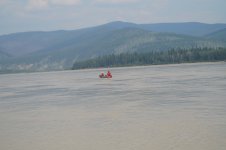
As we approached the next bend in the river, nervous-dog-people again went out and around an island into the wind, riding the strong current toward the distant outside bend. Again, Kathleen and I ducked behind the island into a side channel, where we gravelled out at the entrance. I got out to pull us free, and we ran down a narrow, winding, slow-moving “rapid” for what seemed like a very long time. We now paddled in sluggish water barely deep enough to float the canoe, with no suggestion that we would ever again merge with the main channel. Had we made a mistake? Had we gone up an obscure tributary.
We beached the canoe to assess our position. There was no such tributary on the map, and we could still see the high banks of the Yukon River on the inside bend to our immediate left. Nothing to worry about.
We climbed back into the canoe and headed “downriver” in water too shallow to paddle. We were now pretty much using our paddles to push the canoe forward. After what seemed like an hour, we again beached the canoe to assess our position, and took a GPS reading. Guess what? The GPS said that we were farther north than when we had entered the side channel. This was reaffirming news, as the channel was supposed to be heading north. We had not been heading west up an obscure tributary. What else could we have reasonably expected, though. All this worry for nothing. But, as you must suspect by now, I am a worrier.
As we prepared to resume paddling/pushing, Kathleen said, “Michael, I think I can see wide water on both sides of the next island. We’re almost out.”
We put back on the water, and re-entered the main current just in time to see the nervous-dog-people paddle by. It turned out that their route on the fast current, in the wind, on the distant outside bend, was actually slower than our route on the sluggish current on the nearby inside bend. Interesting. I wonder if the Yukon River Questers take these kinds of shortcuts.
Moments later the Amelia Lupine barge passed us, loaded with containers and a recreational vehicle. At six-thirty we stopped for the day on a very nice, sandy island. We tried to scoop out some clear drinking water, with no success whatsoever. ’Twas a serious mistake not to have filled our 20-litre water jug before reaching the White River. We castigated ourselves, quite severely I might say, and got out our MSR MiniWorks water filter. After filtering only one litre of water, a thick layer of mud completely covered the cartridge. That was enough water, though, for drinking and for cooking our spaghetti supper.
We covered about 90 km (55 miles) today. Only 60 km (37 miles) to Dawson City. Maybe we’ll sleep late tomorrow, as we will likely have a short paddling day. We intend to stop maybe 25 km (15 miles) from Dawson to wash and clean up. We would still arrive in Dawson City mid-morning the following day. Our major goal for tomorrow, though, is to find clear drinking water. We were camped a fairly short distance upriver from Reindeer Creek. Maybe we’ll find water there. For now, though, we filled a pot with water to let it settle overnight.
We retired to the tent, where Kathleen poured two more ounces each of brandy. Normally on canoe trips we enjoy a glass of celebratory brandy only once a week, as we try to conserve our supply. But this Yukon River trip is only 14 days. Conserving brandy seemed less important. But we were perilously close to running dry. We should have brought more.
Last edited:
I'm really enjoying the trip story in full. Side stories, back stories, full stories are all good stories. And the photos are excellent also. I'm impressed with the views! Brandy or no brandy, me and my partner would find it hard going to shift ourselves from some of those shores, layover days being so rewarding. With the puppy enjoying a carefree holiday, the 5 fingers of death behind us, there's only the van to think about. But no. All I'm thinking about is how to stretch out the last paddling day so it lasts forever.
Last edited:
"I wonder if the Yukon River Questers take these kinds of shortcuts." As a Quester, I can tell you that, judging from some of the finish times, that many newcomers might often take blind channels and lose a lot of time struggling to get back into the main current channel. I have become grounded on gravel shoals or in low or zero current water flow from time to time. But as long as there is some visible current and we are headed in the same direction with current, it all flows down and will rejoin the main channel eventually. But maybe with a couple of miles added distance. With experience from multiple trips, one learns to do map pre-study. Google Earth is pretty good and relatively up to date in that regard, but published topo maps are virtually useless due to frequent channel changes year to year. Look for potential flow channels to see if a narrow channel might become excessively wide and thus results in slow moving water before rejoining the main channel, especially in low water level years. I have my favorite always goto shortcut channels, and others that are dogs to avoid. The YRQ starts at noon on a Wednesday. There are two mandatory location rest stops of 7 hours (Carmacks) and 3 hours(Coffee Creek) along the way. The faster boats will finish 7-8pm Friday evening, the slowest a full day later if at all. For the 1000 mile, we finish the Y1K in Six days while averaging 165 miles (265km)/day, including the 6 hour mandatory at non-specific location rest stops each "night". It takes a lot of fresh water to hydrate a voyageur crew of 6 or 7 paddlers that I had on my team. For the Y1K we had chemical packets made by Pur that would settle the silt and purify the water at the same time. We would prepare 5 gallon buckets nightly, ending up with a thick layer of slimy silt on the bottom of the bucket and drinkable (though terrible tasting) water on top. The character of the currents in the wide Yukon change considerably in the Flats and below. You get experience with what is called helicoidal current. In big wide deep water meandering rivers a surface current rushes to the outside of wide bends, only to return along the bottom as it flows downstream in a spriral fashion. Stay too close to the inside bend and as in normal rivers, there is slack water with little current. A short distance from shore there is a brief channel of parallel to downstream flowing current. Beyond that you can get caught in 6mph side flowing helicoidal current that you can't paddle against to correct, rushing you toward the outside bend where you will be forced to paddle a much longer distance around the wide bend and lose considerable time. The trick is to watch for ripples indicating the break in the surface current and to stay in the downstream flow, away from the side rushing current.
Sunday, July 7. Up at seven, looking forward to a short paddling day. Kathleen filtered a litre of water from the pot that had been filled last night. She held out the cartridge. “Look, Michael, completely clean. We could get by even if we don’t find clear water today.”
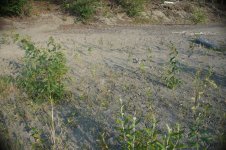
While I began to boil water for tea on the Coleman Peak 1 stove, Kathleen headed down the beach. She returned a few minutes later with news that she had found a nest. “Come over here, Michael. See that bush over there? The nest is under it, on the ground. It has four eggs in it. I think it’s a Spotted Sandpiper’s nest.” (Nest is just to the right, below the leaves, under the large alder on the left. Hard to see.)
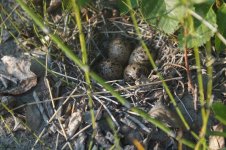
The nest was very nicely hidden, and the eggs blended in quite well with their surroundings. Yet they seemed so vulnerable. One marvels at how any of them survive to adulthood.
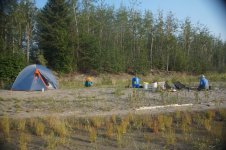 We had found enough wood for me to cook our morning bannock on the fire. Afterwards, I burned some garbage, including a sanitary napkin, that had been left behind for us by fellow travellers down the Yukon River. On marvels at how insensitive and disrespectful some people can be. On the whole, however, our campsites so far had generally been free of garbage garbage—somewhat impressive, given that so many people paddle down the Yukon River.
We had found enough wood for me to cook our morning bannock on the fire. Afterwards, I burned some garbage, including a sanitary napkin, that had been left behind for us by fellow travellers down the Yukon River. On marvels at how insensitive and disrespectful some people can be. On the whole, however, our campsites so far had generally been free of garbage garbage—somewhat impressive, given that so many people paddle down the Yukon River.
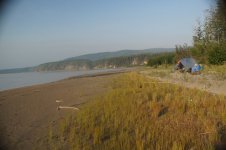
During breakfast, three canoes passed by, way over on river right (Can't see them in this image). Appeared to be two tandem canoes, and one canoe with three people.Through binoculars, they looked like they could be folding canoes, rather than hard to tell. Gear was piled way to high above the gunwales. But who am I to judge? They can pile their gear anyway they please.
They didn’t come over to say hello. Likely the same people that we snubbed yesterday morning. They probably needed to make distance. Probably hoped to reach Dawson City today, only 60 km (37 miles) away.
Kathleen and I put on the water around ten, headed toward Reindeer Creek on river right, where we hoped to find clear water. After all, we had that 20-litre plastic water jug. By all accounts, it was a low water year for the Yukon watershed, and there was no water in Reindeer Creek. We paddled away, more than a little disappointed, particularly since the headwind had once again joined our trip.
After about 15 km (nine miles), we stopped for a snack. I took a GPS reading, and noted that we were just upriver from Galena Creek, on river left. Maybe we’ll find clear water there. After all, Rourke said that the site was formerly Ancient Voices Wilderness Camp. Certainly, any commercial camp would choose to be located near a reliable source of clear, potable water. We were very optimistic.
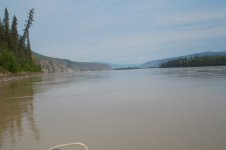
Approaching Galena Creek on river left. As expected, clear water was flowing out of Galena Creek, which was too shallow at its mouth to fill our water jug. We pulled the canoe up onto the beach, tied it to a log, and hiked up the well-marked trail along the creek.
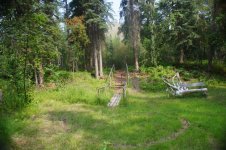
Hiking up trail to find deeper water.
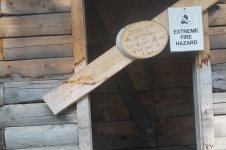
After about a half-a-kilometre (quarter-of-a-mile), I found deeper water, next to a building with a sign that read: Sorry for the inconveniences, but sauna closed if we are in town.
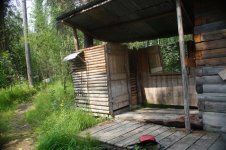
I stepped up onto the porch to have a closer look. Unbeknownst to me, there was a large mirror at the rear of the porch. The sudden appearance of “another person” scared the bejeebers out of me. OK. I might be exaggerating. It did slightly startle me, though.
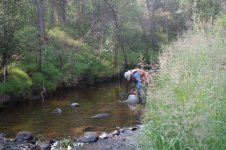
Filling our water jug at Galena Creek.
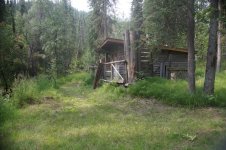
Cabin at Ancient Voices Wilderness Camp.
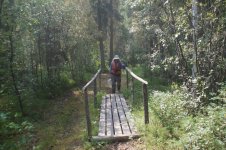
Bringing home the clear water.
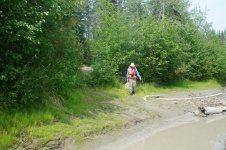
Note the heavy sediment load in the Yukon River.
We learned later, after arriving in Dawson City, that the Ancient Voices Wilderness Camp has closed permanently. The following information is from the ammsa.com website: The Ancient Voices Wilderness Camp will offer tourists hands-on activities at a working Aboriginal camp. Not only does the camp teach hide tanning, fish drying and the preserving of plants and berries, it also offers workshops on such topics as traditional medicines and drum making. Visitors can either take part in the traditional activities offered or choose to relax in the very peaceful setting, located an hour up river from Dawson City.
That would have been interesting. Too bad the camp has closed. The site remains private property. Camping is not permitted.
Minutes downriver we saw a piece of driftwood on the shore, up against the cliff, that looked very much like a resting baby moose. As you likely know, from a distance, driftwood, rocks, stumps and even mounds of dirt often look like animals. As we neared, this piece of driftwood leaped up and ran down the beach, looking even more like a baby moose.
After about an hour, we passed by the “Big White Rock” indicated by Rourke on river left, and began looking for camp, about 20 km (12 miles) from Dawson City. After a frustratingly long search, we finally found an acceptable camp about 14 km (8.5 miles) from Dawson. There was no value in reaching Dawson City today, on a Sunday. We wouldn’t be able to pick up our van until tomorrow. So we sat on the beach, enjoying our gorp snack, in what was our first calm afternoon that we could remember. Sandbar willows swayed gently in the breeze. Flies and bees buzzed softly. The river murmured over shoals on the distant right bank.
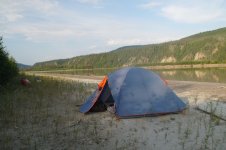
We were camped in a sloughy side channel of the river. Any passing canoes would stay on the far outside bend to ride the strong current. The nearly constant parade of power boats would avoid the shallow water of our slough.
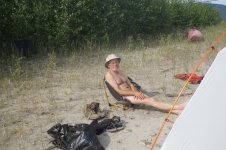
We deemed it safe to strip and bathe, to wash our hair, and to lie about in the sunshine as we drip-dried.
Life was good. Life was easy. Only 14 km to go. Spicy Thai noodles for supper. In the tent at eight-thirty for the last of the brandy. Only 14 km to go to Dawson City. Life was very good, indeed.
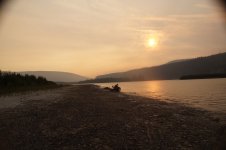
Monday, July 8. We woke at six to a smoke-filled valley. Granola bar for breakfast. On the water at ten minutes after seven. A very good start for us as we paddled toward Dawson City. Our friend “Headwind” joined us for the first hour.
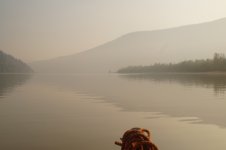
You might remember that I tend to be a worrier. Well, I actually worried just slightly that Kathleen and I might get run over by a speeding power boat that didn’t see us shrouded in all that smoke. I kept my ears and eyes wide open for any impending doom. Kathleen began to fret when he hadn’t reached Dawson by eight-thirty that perhaps we had paddled right on by because of the thick smoke. Of course, both of our worries were groundless and foolish. Gotta worry about something, though, and nothing more worrisome presented itself.
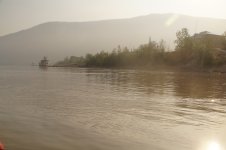
Rourke’s schematic diagram of “Rock Outcrops” on the left bank finally peaked through the smoke, and I knew that we must be nearing Dawson City. The Klondike River soon pushed in with clear, clean water, and moments later, we landed at the dock on Front Street at nine o’clock, right behind the S.S. Keno National Historic Site.
While Kathleen sat on the promenade, watching over the canoe, I walked over to the Klondike Experience office on Second Avenue to ask for a ride out to Advance North Mechanical to get our van. You remember the Klondike Experience as the people with the Husky Bus. The office was closed, however, and I strolled back to Kathleen on the promenade.
“They weren’t there, Kathleen.”
“That’s OK. I’d like to go get a latte, anyway.”
So off she went, down Front Street, while I sat on the promenade, watching over the canoe, enjoying the sun and feeling pleased that we had finally arrived. A few minutes later, Kathleen returned with her latte, as well as a coffee for me. She retrieved her iPad from the canoe, activated its cellular access, and called Advance North Mechanical. Katherine picked me up five minutes later, and I hopped in. This was going very well.
We arrived at the repair shop, where Katherine spent a few minutes searching for our work order among all the others in the slots hanging on the wall.
“You’re here one day sooner that you said you would be back.”
“Well, we got back a day early.”
She finally found the work order in a drawer. She looked at it rather quizzically and
said, “We couldn’t get the parts for the blower motor.”
“That’s not a problem. We can get that fixed when we get home.”
“Do you know you have oil leaks in several places?”
“Yeah, but I never see any oil on the ground.”
“If you see it on the ground, it’s too late. Your van is old, you know.”
“Yeah, it’s old, but it still works.”
“And did you know that your antifreeze is good down to only minus 10 (C)? And did you know your flex hoses for the front wheels are cracked? You shouldn’t be driving this van. It’s got 400,000 km (250,000 miles). It’s old. (Note: I didn’t know I had cracked flex hoses. I don’t know very much about vehicle parts. I didn’t even know flex hoses were.)
“Can you fix the flex hoses? What do they do?”
“They supply fluid to the brakes. We don’t have replacement hoses, and it will take a while to get them. You might make it home.”
“Should I just trash my van?”
“No, you could use it for a storage shed.”
“But I already have a lot of storage sheds.”
“You could use it for a guest cottage.”
“But I already have a guest cottage. Besides, my van is the only vehicle I have ever owned that I truly love.”
“But it’s old. You’re brave to be driving it to the Yukon. It’s got 400,000 km.” (Note: I think it was only diplomacy that prevented her from saying I was stupid to be driving it.)
“Hey,” I said. “I know farmers back home in Preeceville that are still driving vehicles with 500,000 km (300,000 miles).
“But they don’t drive them to the Yukon,do they? We’ve got a vehicle with 500,000 km, and we take good care of it. Even so, we never drive it out of town.
Anyway, I paid for one week of storage in their lot, the oil change, the new windshield wipers and the repaired lock/unlock button on the rear door. I climbed into the van, the only vehicle I have ever truly loved, and drove back to Kathleen on the promenade.
Kathleen had already found a place for us to stay, the Cabin Fever AirBnB. We loaded all of our gear into the van, tied the canoe up on the rack, and checked into our room.
Kathleen emailed the Tails and Trails Dog Hotel at 9:34 a.m. “Good morning Nina, We just arrived in Dawson. Hope all is still going well with Shadow. We plan to stay in Dawson today and tomorrow. We would like to pick Shadow up on Wednesday. What time do we need to get there for pickup?”
We then called Canadian Tire in Whitehorse for an appointment at 10:00 a.m. on Thursday, four days from now. “Can you get flex hoses for the front wheels of a 1990 Ford Econoline van?”
“Sure. Would you like us to do a brake check too?”
Katherine had said that I might be able to get home. If so, I should also be able to get to Whitehorse. I hope so. If nothing else, I finally had something substantive to worry about.
Kathleen received a response from Nina at 11:09 a.m. “Shadow is doing really well! We will miss him here! You can pick Shadow up between eight and ten am, and between three and five pm. Does that work for you? Have a good day!”
We then strolled down to the George Black ferry to say hello to Tommy Taylor. You remember that we looked after Tommy’s 29 sled dogs at Fort Reliance in 2006. Guy on the ferry said Tommy was downriver with some tourists. Tommy owns Fishwheel Charter Services that gives guided tours on the Yukon River, while presenting the history of First Nations people.
Next we stopped at a the Dawson City Visitor Information Centre, just to hang out and look at the historical photos. Chatted to a guy behind one of the counters, and asked him if he knew Dawn Kisoun, who, as you remember, is Tommy’s wife.
“Yeah, I know Dawn. She works right across the street at the Northwest Territories Information Booth.”
“That makes, sense,” I said. “Dawn is from Fort McPherson in the Northwest Territories.”
So we walked across the street, and asked for Dawn.
“This is her day off. She’ll be in tomorrow.”
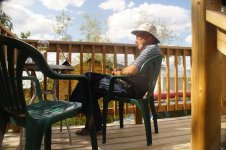
Next Kathleen and I bought a bottle of white wine, salami, cheese and crackers for lunch on our terrace at the Cabin Fever AirBnB. Afterwards, we walked back to town, where I purchased an electric shaver with multiple settings for beard length. To maintain my status as the Handsome Husband required a just-right stubble look. Not too long. Not too short. But just right. As long as I didn’t glance in the mirror, I imagined I looked like one of those young, virile, hockey players—all of whom seem to be sporting that just-right stubble look.
We spent the evening at Diamond Tooth Gertie’s Gambling Hall, where we saw all three shows (8:30 p.m.; 10:00 p.m.; midnight). The vaudevillian-type performances were fantastic—excellent dancing, singing and cheeky, salacious repartee. I had been to Diamond Tooth Gertie’s several times before, and had learned how to avoid being dragged up on stage by the female performers, whose main goal was to embarrass older men. The trick was to always be gambling. You would never be dragged away if you were likely losing money. But I don’t gamble anymore. I don’t like losing money. So, I just sat at my table, in plain view, hoping for the best. And, it turns out, that I was pretty much the only old guy in the entire venue that was not dragged up on stage, or otherwise harassed in place. The only thing I can think of that saved me was my just-right, Handsome Husband stubble look. I must have appeared way too young and virile. Not nearly old enough to be dragged up on stage.
I stumbled home with way too much white wine in my system. But hey, we were in Dawson City. Time to party.
You might be interested in viewing some of the festivities at Diamond Tooth Gertie’s Gambling Hall. If so, please click on the following link.
https://dawsoncity.ca/diamond-tooth-gerties/
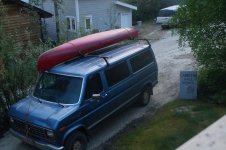
View from our terrace at 1:00 a.m.
Tuesday, July 9. We slept very well, and then enjoyed another hearty breakfast at the Jack London Grill in the Downtown Hotel. Around eleven we strolled over to the Northwest Territories Information Booth, where Dawn was busy with two other tourists. We waited patiently a short distance away. Periodically, Dawn glanced at us with a quizzical expression on her face. When the tourists finally left the counter, we walked up, and said, “Hello, Dawn. This is Michael and Kathleen.” Big hugs followed.
“Sorry I didn’t recognize you right away. but it has been long time. I was thinking to myself, who are those older people staring at me, like I should know them. You should come over to our place at two o’clock for lunch. Tommy will be off work then.”
We enjoyed sharing stories of when Kathleen and I looked after their dogs at Fort Reliance. “Do you remember, Tommy, that first day at the cabin, you said that you and I were going to have a wood-splitting contest. That I could pick any round I wanted to split, and that I could use any of the tools leaning against the wall. I looked over, and saw a splitting wedge and a sledge hammer. I said I’ll use those. You just shook your head, and said no. Those are a woman’s tools. So I selected an axe, and the contest began. You split your round on the first swing. I eyed my round, and hit a glancing blow. You said, Mike, accuracy is the key. I split a lot of wood these days, Tommy, and whenever I miss, I still say to myself—Mike, accuracy is the key.” As he left to go back to work, Tommy gave us one of his cans of King Salmon. ’Twas very tasty!
Afterwards we bought groceries for the road trip home, and some beer and wine for Graham and Amy, as thanks for their hospitality when we were in Whitehorse. We also confirmed that the gas station in town opened at seven. We hoped to get an early start tomorrow, and would need block ice for our cooler.
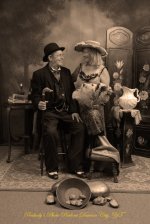
We then paid a visit to Peabody’s Photo Parlour to have our pictures taken while wearing 1890’s attire. We told the photographer that “We want to appear distinguished, and pleased with ourselves for just having struck it rich in the Klondike goldfields.” Probably not all that original, but it seemed appropriate.
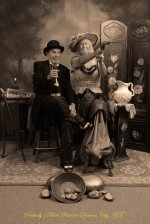
Towards the end of the shoot, the photographer asked, “Would you like to have a gun, Kathleen?
“No.”
I expected that response. Kathleen doesn’t like guns.
“I think it would add a bit of flourish,” he said.
“I think he’s right, Kathleen. It might be fun.”
“Well, ok.”
“Would you like a rifle?” the photographer asked.
“No.”
“OK,” he said. “Here’s a pistol. Pretend there’s someone coming into the room, trying to steal your gold. And you, Michael. Look alarmed.”
I think you will agree that the photographer did a great job. We looked very cute, even charming. For never having held a handgun before, Kathleen fell instantly and easily—even devilishly playful—into her role.
For supper, we sat down in the covered patio at Klondike Kate’s Restaurant, where we ordered Ceaser salad and poutine. Our waitress, like many young women today, was covered in tattoos. One of the designs included the words oro and aqua, which I recognized as Spanish for gold and water, respectively. I asked her what the entire tattoo said.
“Water is more valuable than gold.”
Somewhat ironic, I thought, for a person working in Dawson City, the heart of one the greatest gold rushes of all time.
The young tattoo-covered woman was born in Halifax, but grew up in Argentina. Said that she liked to travel, and could make more money waitressing in Dawson City, than she could working at just about any job in Argentina.
Kathleen and I tumbled into bed early. We had heard that fires were burning within a few kilometres (miles) of the Klondike Highway. Pilot cars were in place to lead vehicles through potentially very thick smoke. If too thick, the highway might even be closed tomorrow. Hope we make it. We gotta pick up Shadow at the Tails and Trails Dog Hotel. We miss that dog.
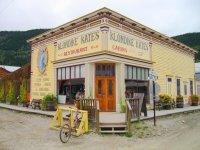
Klondike Kate’s (From yukoninfo.com)
The following blurb is from the restaurant’s webpage: Vivacious, fun loving and perhaps a little rebellious, Klondike Kate made a name for herself dancing on the stages of Dawson City during the height of the Klondike Gold Rush. After moving to the Yukon at the turn of the 20th century, Kate quickly became known for her irresistible charm and ability to mesmerize audiences with her cutting-edge dance routines. Kate was coined the “Queen of the Klondike” by her devoted following of gold miners, and has remained a Klondike icon ever since.
The image on the side of the building is Klondike Kate, born Kathleen Rockwell, in 1873, in Kansas City. The images below certainly suggest that she was indeed vivacious. She is quoted as saying, “The men did not come to the Yukon for the gold; they came to see me.” Now that hints of fun loving!
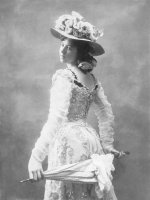
Kathleen “Klondike Kate” Rockwell (From en.wikipedia.org)
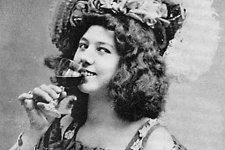
Kathleen “Klondike Kate” Rockwell (From reddit.com)
Some of you might know, however that there was another Klondike Kate, considered by many sources to be the “real” Klondike Kate.
The following is taken from an article by Laurel Downing Bill: Anyone interested in the Klondike gold-rush era has heard of the infamous Klondike Kate, a dancehall gal who mesmerized miners with her moves. Kathleen Rockwell earned quite the reputation for her flirtatious dancing. But there was another girl named Kate who also traveled north and gained some notoriety as a cook, nurse and jailer.
Ill-fated love led this Canadian girl to set out for the Klondike in 1898. When Katherine Ryan heard newspaper boys shouting out the headlines about gold found in the Yukon, she decided to head off into the rugged terrain to seek adventure.
Ryan was the authentic Kate, according to Ann Brennan in her book, The Real Klondike Kate. She'd first made her way to Seattle, then Vancouver, after she'd given her heart to a man who would never be hers. She'd fallen in love with Simon Gallagher, part of the local gentry from her hometown of Johnville, New Brunswick, a rural community northeast of Bath in Carleton County.
Gallagher's mother, however, would not allow the two of them to be together, since Ryan was from a poor family and not worthy of her son. After the mother insisted her son enter the seminary, Ryan headed to Seattle to become a nurse in 1893. When she heard the news of gold strikes in the Klondike, the 28- year-old hopped on board a steamship bound for Southeast Alaska in February 1898. While thousands of stampeders headed to the Klondike via the Chilkoot Trail out of Skagway, Kate Ryan chose the less traveled Stikine River route out of Wrangell.
While in Wrangell, she offered to cook for a group of North West Mounted Police, who then gratefully included her with their group to hike the muddy and brutal Stikine trail. They trudged through deep snow, praying the weather would not warm and turn the river into a torrent of wet fury.
When the policemen stopped to make a permanent camp, Kate continued on alone in her quest to reach Glenora, a tiny settlement built for about a dozen people that had swelled to more than 3,000 as prospectors streamed in on their way to the Klondike.
Kate spent the summer in Glenora, operating a restaurant in a new hotel and washing clothes. Then she bought supplies and continued her journey, leading a string of packhorses up the trail from Glenora to Telegraph Creek and on to the Teslin Trail. She swapped her horses for a sled and dog team in Teslin City, and then made her way to Atlin camp, 60 miles away, where she'd heard her medical skills were needed.
Atlin, which consisted of a few log buildings and half-a-dozen tents in winter 1898, proved to be a challenge for Kate. She started another restaurant in a 12-foot-by-14-foot canvas tent and practiced her nursing upon the sick.
The next spring, she packed up her meager belongings and walked on to Whitehorse. There she pitched her tent, put on a pot of coffee and hung a sign reading "Kate's Café" outside the door. After two years, she built one of the first frame houses in Whitehorse and took space in a new hotel for her restaurant.
When the Mounties approached her and asked if she'd consider becoming the first "constable special" to guard women in the Whitehorse jail, she agreed. With a height approaching six feet, she never had any problems with the "troubled" women she came across.
Ryan, who never married, remained in Whitehorse until 1919 raising her widowed brother's sons, running her business and working as a gold inspector for the Mounted Police. She died peacefully in Vancouver in 1932.
Other articles indicate that Katherine Ryan was dubbed “Klondike Kate” soon after arriving in Whitehorse, and before Kathleen Rockwell appropriated the nickname for herself. Apparently Katherine Ryan was somewhat chagrined when people assumed that she had been guilty of the “rebellious” escapades of her namesake.
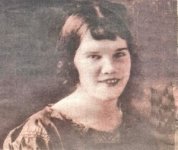
Katherine “Klondike Kate” Ryan (From altonm.ca)
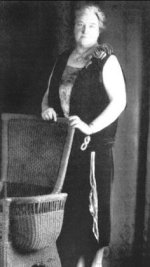
Katherine “Klondike Kate” Ryan (From altonm.ca)

While I began to boil water for tea on the Coleman Peak 1 stove, Kathleen headed down the beach. She returned a few minutes later with news that she had found a nest. “Come over here, Michael. See that bush over there? The nest is under it, on the ground. It has four eggs in it. I think it’s a Spotted Sandpiper’s nest.” (Nest is just to the right, below the leaves, under the large alder on the left. Hard to see.)

The nest was very nicely hidden, and the eggs blended in quite well with their surroundings. Yet they seemed so vulnerable. One marvels at how any of them survive to adulthood.
 We had found enough wood for me to cook our morning bannock on the fire. Afterwards, I burned some garbage, including a sanitary napkin, that had been left behind for us by fellow travellers down the Yukon River. On marvels at how insensitive and disrespectful some people can be. On the whole, however, our campsites so far had generally been free of garbage garbage—somewhat impressive, given that so many people paddle down the Yukon River.
We had found enough wood for me to cook our morning bannock on the fire. Afterwards, I burned some garbage, including a sanitary napkin, that had been left behind for us by fellow travellers down the Yukon River. On marvels at how insensitive and disrespectful some people can be. On the whole, however, our campsites so far had generally been free of garbage garbage—somewhat impressive, given that so many people paddle down the Yukon River.
During breakfast, three canoes passed by, way over on river right (Can't see them in this image). Appeared to be two tandem canoes, and one canoe with three people.Through binoculars, they looked like they could be folding canoes, rather than hard to tell. Gear was piled way to high above the gunwales. But who am I to judge? They can pile their gear anyway they please.
They didn’t come over to say hello. Likely the same people that we snubbed yesterday morning. They probably needed to make distance. Probably hoped to reach Dawson City today, only 60 km (37 miles) away.
Kathleen and I put on the water around ten, headed toward Reindeer Creek on river right, where we hoped to find clear water. After all, we had that 20-litre plastic water jug. By all accounts, it was a low water year for the Yukon watershed, and there was no water in Reindeer Creek. We paddled away, more than a little disappointed, particularly since the headwind had once again joined our trip.
After about 15 km (nine miles), we stopped for a snack. I took a GPS reading, and noted that we were just upriver from Galena Creek, on river left. Maybe we’ll find clear water there. After all, Rourke said that the site was formerly Ancient Voices Wilderness Camp. Certainly, any commercial camp would choose to be located near a reliable source of clear, potable water. We were very optimistic.

Approaching Galena Creek on river left. As expected, clear water was flowing out of Galena Creek, which was too shallow at its mouth to fill our water jug. We pulled the canoe up onto the beach, tied it to a log, and hiked up the well-marked trail along the creek.

Hiking up trail to find deeper water.

After about a half-a-kilometre (quarter-of-a-mile), I found deeper water, next to a building with a sign that read: Sorry for the inconveniences, but sauna closed if we are in town.

I stepped up onto the porch to have a closer look. Unbeknownst to me, there was a large mirror at the rear of the porch. The sudden appearance of “another person” scared the bejeebers out of me. OK. I might be exaggerating. It did slightly startle me, though.

Filling our water jug at Galena Creek.

Cabin at Ancient Voices Wilderness Camp.

Bringing home the clear water.

Note the heavy sediment load in the Yukon River.
We learned later, after arriving in Dawson City, that the Ancient Voices Wilderness Camp has closed permanently. The following information is from the ammsa.com website: The Ancient Voices Wilderness Camp will offer tourists hands-on activities at a working Aboriginal camp. Not only does the camp teach hide tanning, fish drying and the preserving of plants and berries, it also offers workshops on such topics as traditional medicines and drum making. Visitors can either take part in the traditional activities offered or choose to relax in the very peaceful setting, located an hour up river from Dawson City.
That would have been interesting. Too bad the camp has closed. The site remains private property. Camping is not permitted.
Minutes downriver we saw a piece of driftwood on the shore, up against the cliff, that looked very much like a resting baby moose. As you likely know, from a distance, driftwood, rocks, stumps and even mounds of dirt often look like animals. As we neared, this piece of driftwood leaped up and ran down the beach, looking even more like a baby moose.
After about an hour, we passed by the “Big White Rock” indicated by Rourke on river left, and began looking for camp, about 20 km (12 miles) from Dawson City. After a frustratingly long search, we finally found an acceptable camp about 14 km (8.5 miles) from Dawson. There was no value in reaching Dawson City today, on a Sunday. We wouldn’t be able to pick up our van until tomorrow. So we sat on the beach, enjoying our gorp snack, in what was our first calm afternoon that we could remember. Sandbar willows swayed gently in the breeze. Flies and bees buzzed softly. The river murmured over shoals on the distant right bank.

We were camped in a sloughy side channel of the river. Any passing canoes would stay on the far outside bend to ride the strong current. The nearly constant parade of power boats would avoid the shallow water of our slough.

We deemed it safe to strip and bathe, to wash our hair, and to lie about in the sunshine as we drip-dried.
Life was good. Life was easy. Only 14 km to go. Spicy Thai noodles for supper. In the tent at eight-thirty for the last of the brandy. Only 14 km to go to Dawson City. Life was very good, indeed.

Monday, July 8. We woke at six to a smoke-filled valley. Granola bar for breakfast. On the water at ten minutes after seven. A very good start for us as we paddled toward Dawson City. Our friend “Headwind” joined us for the first hour.

You might remember that I tend to be a worrier. Well, I actually worried just slightly that Kathleen and I might get run over by a speeding power boat that didn’t see us shrouded in all that smoke. I kept my ears and eyes wide open for any impending doom. Kathleen began to fret when he hadn’t reached Dawson by eight-thirty that perhaps we had paddled right on by because of the thick smoke. Of course, both of our worries were groundless and foolish. Gotta worry about something, though, and nothing more worrisome presented itself.

Rourke’s schematic diagram of “Rock Outcrops” on the left bank finally peaked through the smoke, and I knew that we must be nearing Dawson City. The Klondike River soon pushed in with clear, clean water, and moments later, we landed at the dock on Front Street at nine o’clock, right behind the S.S. Keno National Historic Site.
While Kathleen sat on the promenade, watching over the canoe, I walked over to the Klondike Experience office on Second Avenue to ask for a ride out to Advance North Mechanical to get our van. You remember the Klondike Experience as the people with the Husky Bus. The office was closed, however, and I strolled back to Kathleen on the promenade.
“They weren’t there, Kathleen.”
“That’s OK. I’d like to go get a latte, anyway.”
So off she went, down Front Street, while I sat on the promenade, watching over the canoe, enjoying the sun and feeling pleased that we had finally arrived. A few minutes later, Kathleen returned with her latte, as well as a coffee for me. She retrieved her iPad from the canoe, activated its cellular access, and called Advance North Mechanical. Katherine picked me up five minutes later, and I hopped in. This was going very well.
We arrived at the repair shop, where Katherine spent a few minutes searching for our work order among all the others in the slots hanging on the wall.
“You’re here one day sooner that you said you would be back.”
“Well, we got back a day early.”
She finally found the work order in a drawer. She looked at it rather quizzically and
said, “We couldn’t get the parts for the blower motor.”
“That’s not a problem. We can get that fixed when we get home.”
“Do you know you have oil leaks in several places?”
“Yeah, but I never see any oil on the ground.”
“If you see it on the ground, it’s too late. Your van is old, you know.”
“Yeah, it’s old, but it still works.”
“And did you know that your antifreeze is good down to only minus 10 (C)? And did you know your flex hoses for the front wheels are cracked? You shouldn’t be driving this van. It’s got 400,000 km (250,000 miles). It’s old. (Note: I didn’t know I had cracked flex hoses. I don’t know very much about vehicle parts. I didn’t even know flex hoses were.)
“Can you fix the flex hoses? What do they do?”
“They supply fluid to the brakes. We don’t have replacement hoses, and it will take a while to get them. You might make it home.”
“Should I just trash my van?”
“No, you could use it for a storage shed.”
“But I already have a lot of storage sheds.”
“You could use it for a guest cottage.”
“But I already have a guest cottage. Besides, my van is the only vehicle I have ever owned that I truly love.”
“But it’s old. You’re brave to be driving it to the Yukon. It’s got 400,000 km.” (Note: I think it was only diplomacy that prevented her from saying I was stupid to be driving it.)
“Hey,” I said. “I know farmers back home in Preeceville that are still driving vehicles with 500,000 km (300,000 miles).
“But they don’t drive them to the Yukon,do they? We’ve got a vehicle with 500,000 km, and we take good care of it. Even so, we never drive it out of town.
Anyway, I paid for one week of storage in their lot, the oil change, the new windshield wipers and the repaired lock/unlock button on the rear door. I climbed into the van, the only vehicle I have ever truly loved, and drove back to Kathleen on the promenade.
Kathleen had already found a place for us to stay, the Cabin Fever AirBnB. We loaded all of our gear into the van, tied the canoe up on the rack, and checked into our room.
Kathleen emailed the Tails and Trails Dog Hotel at 9:34 a.m. “Good morning Nina, We just arrived in Dawson. Hope all is still going well with Shadow. We plan to stay in Dawson today and tomorrow. We would like to pick Shadow up on Wednesday. What time do we need to get there for pickup?”
We then called Canadian Tire in Whitehorse for an appointment at 10:00 a.m. on Thursday, four days from now. “Can you get flex hoses for the front wheels of a 1990 Ford Econoline van?”
“Sure. Would you like us to do a brake check too?”
Katherine had said that I might be able to get home. If so, I should also be able to get to Whitehorse. I hope so. If nothing else, I finally had something substantive to worry about.
Kathleen received a response from Nina at 11:09 a.m. “Shadow is doing really well! We will miss him here! You can pick Shadow up between eight and ten am, and between three and five pm. Does that work for you? Have a good day!”
We then strolled down to the George Black ferry to say hello to Tommy Taylor. You remember that we looked after Tommy’s 29 sled dogs at Fort Reliance in 2006. Guy on the ferry said Tommy was downriver with some tourists. Tommy owns Fishwheel Charter Services that gives guided tours on the Yukon River, while presenting the history of First Nations people.
Next we stopped at a the Dawson City Visitor Information Centre, just to hang out and look at the historical photos. Chatted to a guy behind one of the counters, and asked him if he knew Dawn Kisoun, who, as you remember, is Tommy’s wife.
“Yeah, I know Dawn. She works right across the street at the Northwest Territories Information Booth.”
“That makes, sense,” I said. “Dawn is from Fort McPherson in the Northwest Territories.”
So we walked across the street, and asked for Dawn.
“This is her day off. She’ll be in tomorrow.”

Next Kathleen and I bought a bottle of white wine, salami, cheese and crackers for lunch on our terrace at the Cabin Fever AirBnB. Afterwards, we walked back to town, where I purchased an electric shaver with multiple settings for beard length. To maintain my status as the Handsome Husband required a just-right stubble look. Not too long. Not too short. But just right. As long as I didn’t glance in the mirror, I imagined I looked like one of those young, virile, hockey players—all of whom seem to be sporting that just-right stubble look.
We spent the evening at Diamond Tooth Gertie’s Gambling Hall, where we saw all three shows (8:30 p.m.; 10:00 p.m.; midnight). The vaudevillian-type performances were fantastic—excellent dancing, singing and cheeky, salacious repartee. I had been to Diamond Tooth Gertie’s several times before, and had learned how to avoid being dragged up on stage by the female performers, whose main goal was to embarrass older men. The trick was to always be gambling. You would never be dragged away if you were likely losing money. But I don’t gamble anymore. I don’t like losing money. So, I just sat at my table, in plain view, hoping for the best. And, it turns out, that I was pretty much the only old guy in the entire venue that was not dragged up on stage, or otherwise harassed in place. The only thing I can think of that saved me was my just-right, Handsome Husband stubble look. I must have appeared way too young and virile. Not nearly old enough to be dragged up on stage.
I stumbled home with way too much white wine in my system. But hey, we were in Dawson City. Time to party.
You might be interested in viewing some of the festivities at Diamond Tooth Gertie’s Gambling Hall. If so, please click on the following link.
https://dawsoncity.ca/diamond-tooth-gerties/

View from our terrace at 1:00 a.m.
Tuesday, July 9. We slept very well, and then enjoyed another hearty breakfast at the Jack London Grill in the Downtown Hotel. Around eleven we strolled over to the Northwest Territories Information Booth, where Dawn was busy with two other tourists. We waited patiently a short distance away. Periodically, Dawn glanced at us with a quizzical expression on her face. When the tourists finally left the counter, we walked up, and said, “Hello, Dawn. This is Michael and Kathleen.” Big hugs followed.
“Sorry I didn’t recognize you right away. but it has been long time. I was thinking to myself, who are those older people staring at me, like I should know them. You should come over to our place at two o’clock for lunch. Tommy will be off work then.”
We enjoyed sharing stories of when Kathleen and I looked after their dogs at Fort Reliance. “Do you remember, Tommy, that first day at the cabin, you said that you and I were going to have a wood-splitting contest. That I could pick any round I wanted to split, and that I could use any of the tools leaning against the wall. I looked over, and saw a splitting wedge and a sledge hammer. I said I’ll use those. You just shook your head, and said no. Those are a woman’s tools. So I selected an axe, and the contest began. You split your round on the first swing. I eyed my round, and hit a glancing blow. You said, Mike, accuracy is the key. I split a lot of wood these days, Tommy, and whenever I miss, I still say to myself—Mike, accuracy is the key.” As he left to go back to work, Tommy gave us one of his cans of King Salmon. ’Twas very tasty!
Afterwards we bought groceries for the road trip home, and some beer and wine for Graham and Amy, as thanks for their hospitality when we were in Whitehorse. We also confirmed that the gas station in town opened at seven. We hoped to get an early start tomorrow, and would need block ice for our cooler.

We then paid a visit to Peabody’s Photo Parlour to have our pictures taken while wearing 1890’s attire. We told the photographer that “We want to appear distinguished, and pleased with ourselves for just having struck it rich in the Klondike goldfields.” Probably not all that original, but it seemed appropriate.

Towards the end of the shoot, the photographer asked, “Would you like to have a gun, Kathleen?
“No.”
I expected that response. Kathleen doesn’t like guns.
“I think it would add a bit of flourish,” he said.
“I think he’s right, Kathleen. It might be fun.”
“Well, ok.”
“Would you like a rifle?” the photographer asked.
“No.”
“OK,” he said. “Here’s a pistol. Pretend there’s someone coming into the room, trying to steal your gold. And you, Michael. Look alarmed.”
I think you will agree that the photographer did a great job. We looked very cute, even charming. For never having held a handgun before, Kathleen fell instantly and easily—even devilishly playful—into her role.
For supper, we sat down in the covered patio at Klondike Kate’s Restaurant, where we ordered Ceaser salad and poutine. Our waitress, like many young women today, was covered in tattoos. One of the designs included the words oro and aqua, which I recognized as Spanish for gold and water, respectively. I asked her what the entire tattoo said.
“Water is more valuable than gold.”
Somewhat ironic, I thought, for a person working in Dawson City, the heart of one the greatest gold rushes of all time.
The young tattoo-covered woman was born in Halifax, but grew up in Argentina. Said that she liked to travel, and could make more money waitressing in Dawson City, than she could working at just about any job in Argentina.
Kathleen and I tumbled into bed early. We had heard that fires were burning within a few kilometres (miles) of the Klondike Highway. Pilot cars were in place to lead vehicles through potentially very thick smoke. If too thick, the highway might even be closed tomorrow. Hope we make it. We gotta pick up Shadow at the Tails and Trails Dog Hotel. We miss that dog.

Klondike Kate’s (From yukoninfo.com)
The following blurb is from the restaurant’s webpage: Vivacious, fun loving and perhaps a little rebellious, Klondike Kate made a name for herself dancing on the stages of Dawson City during the height of the Klondike Gold Rush. After moving to the Yukon at the turn of the 20th century, Kate quickly became known for her irresistible charm and ability to mesmerize audiences with her cutting-edge dance routines. Kate was coined the “Queen of the Klondike” by her devoted following of gold miners, and has remained a Klondike icon ever since.
The image on the side of the building is Klondike Kate, born Kathleen Rockwell, in 1873, in Kansas City. The images below certainly suggest that she was indeed vivacious. She is quoted as saying, “The men did not come to the Yukon for the gold; they came to see me.” Now that hints of fun loving!

Kathleen “Klondike Kate” Rockwell (From en.wikipedia.org)

Kathleen “Klondike Kate” Rockwell (From reddit.com)
Some of you might know, however that there was another Klondike Kate, considered by many sources to be the “real” Klondike Kate.
The following is taken from an article by Laurel Downing Bill: Anyone interested in the Klondike gold-rush era has heard of the infamous Klondike Kate, a dancehall gal who mesmerized miners with her moves. Kathleen Rockwell earned quite the reputation for her flirtatious dancing. But there was another girl named Kate who also traveled north and gained some notoriety as a cook, nurse and jailer.
Ill-fated love led this Canadian girl to set out for the Klondike in 1898. When Katherine Ryan heard newspaper boys shouting out the headlines about gold found in the Yukon, she decided to head off into the rugged terrain to seek adventure.
Ryan was the authentic Kate, according to Ann Brennan in her book, The Real Klondike Kate. She'd first made her way to Seattle, then Vancouver, after she'd given her heart to a man who would never be hers. She'd fallen in love with Simon Gallagher, part of the local gentry from her hometown of Johnville, New Brunswick, a rural community northeast of Bath in Carleton County.
Gallagher's mother, however, would not allow the two of them to be together, since Ryan was from a poor family and not worthy of her son. After the mother insisted her son enter the seminary, Ryan headed to Seattle to become a nurse in 1893. When she heard the news of gold strikes in the Klondike, the 28- year-old hopped on board a steamship bound for Southeast Alaska in February 1898. While thousands of stampeders headed to the Klondike via the Chilkoot Trail out of Skagway, Kate Ryan chose the less traveled Stikine River route out of Wrangell.
While in Wrangell, she offered to cook for a group of North West Mounted Police, who then gratefully included her with their group to hike the muddy and brutal Stikine trail. They trudged through deep snow, praying the weather would not warm and turn the river into a torrent of wet fury.
When the policemen stopped to make a permanent camp, Kate continued on alone in her quest to reach Glenora, a tiny settlement built for about a dozen people that had swelled to more than 3,000 as prospectors streamed in on their way to the Klondike.
Kate spent the summer in Glenora, operating a restaurant in a new hotel and washing clothes. Then she bought supplies and continued her journey, leading a string of packhorses up the trail from Glenora to Telegraph Creek and on to the Teslin Trail. She swapped her horses for a sled and dog team in Teslin City, and then made her way to Atlin camp, 60 miles away, where she'd heard her medical skills were needed.
Atlin, which consisted of a few log buildings and half-a-dozen tents in winter 1898, proved to be a challenge for Kate. She started another restaurant in a 12-foot-by-14-foot canvas tent and practiced her nursing upon the sick.
The next spring, she packed up her meager belongings and walked on to Whitehorse. There she pitched her tent, put on a pot of coffee and hung a sign reading "Kate's Café" outside the door. After two years, she built one of the first frame houses in Whitehorse and took space in a new hotel for her restaurant.
When the Mounties approached her and asked if she'd consider becoming the first "constable special" to guard women in the Whitehorse jail, she agreed. With a height approaching six feet, she never had any problems with the "troubled" women she came across.
Ryan, who never married, remained in Whitehorse until 1919 raising her widowed brother's sons, running her business and working as a gold inspector for the Mounted Police. She died peacefully in Vancouver in 1932.
Other articles indicate that Katherine Ryan was dubbed “Klondike Kate” soon after arriving in Whitehorse, and before Kathleen Rockwell appropriated the nickname for herself. Apparently Katherine Ryan was somewhat chagrined when people assumed that she had been guilty of the “rebellious” escapades of her namesake.

Katherine “Klondike Kate” Ryan (From altonm.ca)

Katherine “Klondike Kate” Ryan (From altonm.ca)
Attachments
Last edited:
"We then paid a visit to Peabody’s Photo Parlour to have our pictures taken while wearing 1890’s attire. We told the photographer that “We want to appear distinguished, and pleased with ourselves for just having struck it rich in the Klondike goldfields.” Probably not all that original, but it seemed appropriate."
You two did strike it rich Michael. Great trip.
You two did strike it rich Michael. Great trip.
We have loved all our stays in Dawson City but when we first visited it was via canoe . We took in the historical sights and the first nights dinner post cleanup was at Klondike Kates. We were blown away by finding out that not only was Dawson one of the first cities in North America to be electrified in 1898 that it was up to speed and way beyond what we knew as an Internet experience in 2012.
You see at home you order, the server runs your order to the kitchen then runs back to take care of others then runs back to the kitchen to get your food. runs your food to you. Then the credit card dance. Server gives you your bill runs around to not bother you while you fish for your wallet and credit card then takes the card and the bill somewhere mysterious and eventually ( minutes to what seems like hours later) returns your card and the printout.
At Klondike Kates the server sent the order to the kitchen via I pad.. Took other orders via I pad..When the food was ready was notified by I pad went to get it and brought it to us. When we were done here was the bill and the card reader ( at that time and mostly still UNHEARD of in the USA!). No credit card had to go on a trip alone!
I thought the juxtaposition of modern and history exquisite.
You see at home you order, the server runs your order to the kitchen then runs back to take care of others then runs back to the kitchen to get your food. runs your food to you. Then the credit card dance. Server gives you your bill runs around to not bother you while you fish for your wallet and credit card then takes the card and the bill somewhere mysterious and eventually ( minutes to what seems like hours later) returns your card and the printout.
At Klondike Kates the server sent the order to the kitchen via I pad.. Took other orders via I pad..When the food was ready was notified by I pad went to get it and brought it to us. When we were done here was the bill and the card reader ( at that time and mostly still UNHEARD of in the USA!). No credit card had to go on a trip alone!
I thought the juxtaposition of modern and history exquisite.
The trip is not over yet, Odyssey. We still gotta get home, and our flex hoses are cracked.
Like you, yellowcanoe, Kathleen and I love Dawson. Some acquaintances of ours here in Preeceville went to Dawson this summer, and didn’t like it. Said there was no history to see. I was flabbergasted. Said they much preferred Deadwood, South Dakota.
Like you, yellowcanoe, Kathleen and I love Dawson. Some acquaintances of ours here in Preeceville went to Dawson this summer, and didn’t like it. Said there was no history to see. I was flabbergasted. Said they much preferred Deadwood, South Dakota.
Wednesday, July 10. Kathleen and I got p at 6:00 a.m., packed quickly, and arrived at the gas station for gas and ice promptly at 7:00 a.m.
“Do you want to stop at the bistro to get a latte, Kathleen?”
“I don’t know. We need to get going.”
“It doesn’t take very long. You know you like to have a latte in the morning.”
“Yeah, I do. OK.”
So we drove down to the Riverwest Bistro on Front Street, where we stood in line to get a latte for Kathleen, and a coffee for me. Back in the van, we headed south down the north Klondike highway, hoping for the best. Hoping that our breaks didn’t go out. Hoping that we could get through the smoke. Although a lot of smoke shrouded the highway, other vehicles were coming north, and when we reached the spot predicted to most smoky, the pilot car was parked on the side of the road. So far, so good.
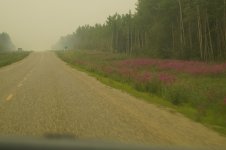
Fireweed blooming along the smoke-shrouded North Klondike Highway.
We stopped at the Coal Mine Campground, where we bought two “Klondike Quickies,” a great bacon/egg/cheese sandwich for only $6.00 each. A real bargain. A small dog trailed us down to the picnic table near the river—mooching all the way. He was out of luck, though. Kathleen and I don’t ever feed Shadow bites from our meals. And he’s our dog. He quickly learned that mooching doesn’t pay. Speaking of Shadow, the grand reunion was now only about two hours away.
Kathleen and I arrived at the Tails and Trails Dog Hotel at 2:15 p.m. Too early by forty-five minutes. Nina had said that we could pick Shadow up between three and six in the afternoon. We got out of the van anyway, and knocked on the office door. No answer. Dogs in their runs were going berserk. Shadow is a quiet dog, and rarely barks or gets overly excited. He just sat there, looking at us just like Dawn looked at us in the Northwest Territories Information Booth. He seemed to be thinking, “Who are these old people staring at me like I should know them?” After a few minutes, Shadow began to shift his weight back-and-forth, from one front foot to the other. Then he began to howl. It was beautiful to hear. Shadow certainly recognized us now.
“What should we do, Michael? I don’t want to just drive away. And we can’t just sit here doing nothing. I’m going to called Nina, and see if she can come early.”
Nina arrived 15 minutes later, and led us into the reception area. “Let me go get Shadow,” she said. “I’ll bring him out to you.”
Nina brought Shadow into the hallway, and he trotted toward Kathleen. He appeared uncertain. Then he turned and trotted back to Nina. He turned, and again approached Kathleen, somewhat cautiously. He turned his head to look back at Nina, and then finally ran up to Kathleen to bury his heads between her legs. Nina had cared for Shadow for 17 days, and she had gained his trust. That spoke well for Nina, and confirmed that Shadow had felt safe and secure at the Tails and Trails Dog Hotel.
Nina presented the invoice. “The total is $408.00, (17 days @ $24.00/day) minus a 10% discount for a stay longer than 14 days. This brings the final total to $367.20.”
“How ‘bout I write a cheque for $400.00?”
Nina’s eyes got big, just like Rainer’s eyes when we told him that we had paddled the Rock Gardens on the South Nahanni River.
“No one has ever tipped before.”
“Well, I tip wait staff 20% just for taking my order and bringing my plate. You looked after my dog every day. And you obviously did a great job.”
We loaded up all of Shadow’s stuff into the van, and he leaped in to curl up in his bed. Kathleen and I then drove the short distance to the Takhini Hot Springs Campground, where we enjoyed a celebratory glass of white wine before supper. Shadow looked very comfortable. Kathleen and I then strolled over to the hot pools for a relaxing soak, followed by an early bed time. All three of us us fell asleep, within touching distance, in the back of the van. It felt fantastic for the family to finally be all together again.
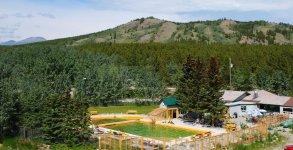
Takhini Springs Hot Pools, (From takhinihotsprings.com)
Thursday, July 11. After a very good sleep for all three of us, we drove into Whitehorse for a bagel and breakfast sandwich at Timmy’s at 8:00 a.m.We wanted to get an early start. We wanted to get the cracked flex hoses fixed as early in the day as possible. We wanted to get headed south to put in some distance.
After shopping for more groceries for the road trip, we drove the van into Canadian Tire’s service area at 9:45 a.m. I asked Stephen, the service representative, if he had a gas cap available. I had forgotten mine on the pump in Dawson City. Also told Stephen that my antifreeze was good only down to minus ten.
“Well, we do have a gas cap that fits your van. And we can flush the radiator for you.”
Shadow, Kathleen and I all sat down in the reception area, expecting to see eager mechanics sprinting toward our vehicle. Our expectation proved to be ill-founded. The van didn’t get lifted up on the hoist until 11:30 a.m. The only good aspect of this unwelcome wait, was that Shadow hadn’t flinched when new people came into his space. We tried to encourage him to leave the reception room, to venture into the main part of Canadian Tire. He wouldn’t leave the room though. Still not trusting new, large unknown, indoor spaces.
A couple of hours later, Stephen came with the bad news. “I’m afraid that the mechanic has confirmed that your flex hoses are cracked.”
“Yeah, we knew that. So can you replace them?”
“Not today. It would take five days to get new flex hoses.”
“That’s disappointing, Stephen. Is it safe to drive?”
“I wouldn’t drive it,” he said. “What would you like us to do?”
“I better talk to Kathleen.”
We faced about seven days of driving to get home to Preeceville. Adding another five days meant that we wouldn’t get home until around July 23. We had bed and breakfast guests booked for the night of July 20. We had to be home no later than July 19.
“So what should we do, Michael?”
“I don’t know, Kathleen. Maybe we could rent a U-Haul truck to get all our stuff home. I could then fly back to Whitehorse to get the van.”
“I don’t like that too much, Michael.”
“Neither do I. Let me go talk to Stephen again. He probably said it wasn’t safe to drive as a safety/liability thing.”
I went back to the service desk. “Is the van really unsafe to drive, Stephen?”
“Come on back with me. I’ll let you talk to the mechanic.”
So Stephen led me into the service area to meet the mechanic. The van was still up on the lift. He started twisting the left hose pretty dang harshly, I thought. “Hey, be careful. Don’t they already have cracks?”
“They’re supposed to twist,” he said.
I peered at the hose. “I don’t see any cracks.”
“They’re small. Do you carry vice grips? You should always carry vice grips in your vehicle.”
“I have vice grips in my canoe repair kit. What would I do with them?”
“If the hose starts to leak, just clamp it off with the grips. I’ll show you.”
“Well if I do that, won’t that stop brake fluid from getting to the wheel?
“”Yeah, but you would still have fluid going to the other three wheels. It wouldn’t leak out completely.”
“So would you drive this van with these cracked hoses?”
“Sure. You’ve already come 500 km from Dawson City. Why not go some more? Old-timers used to drive these roads in old cars with almost no services. You’ll have plenty of services along the way. Have an adventure.”
“OK. I think I’ll chance it.”
I walked back to Kathleen in the reception area, and told her what the mechanic said. “Why don’t you go ask Stephen if you can talk to the mechanic, and look at the flex hoses, Kathleen. See what you think.”
So Kathleen went to see Stephen, who didn’t let her go into the service area: Employees Only. She came back to report that Stephen told her, “You’re more likely to hit a moose or bison, than your brakes will fail.”
So that settled it. We’re going to chance driving home. When I went to sign the papers, I pointed out to Stephen that he was much more optimistic with Kathleen than he was with me.
“I just told her that to make her feel better. ”
“You shouldn’t have told me that, Stephen. You’re not making me feel any better. I think we are gonna go though. We plan to go down the Stewart-Cassiar highway, which doesn’t have quite so many steep and long hills as the Alaska Highway. I think there’s only a couple of spots where the grades are as much as eight percent. We’ll be going through Prince George. Do you think the Canadian Tire there could get replacement flex hoses?”
“Yeah, they can,” Stephen said. “Prince George has five suppliers in town. They can easily get your parts.” Stephen called Prince George to make an appointment for us at 7:30 a.m. for next Tuesday. he also told them what parts we needed for the flex hoses and the blower motor.
“I don’t think we’ll wait to flush the radiator, Stephen. We can do that in Prince George.” I paid for the brake check and the replacement gas cap, and we headed over to Timmy’s for an apple fritter. We badly needed some comfort food.
It’s only 1,619 km (1,004 miles) to Prince George. I planned to go easy on my brakes. Gear down when necessary. Slow down well ahead of turns on the highway. And, as I learned, I didn’t actually have to brake all that often. In fact, I used the brakes only once in nearly 160 km (99 miles) between Whitehorse and the Teslin Lake campground, where we stopped for the night. And even then, I braked only because someone ahead of me was turning left off the narrow highway that had only one lane each way. It turns out that you don’t need brakes if you never use them. Who knew?
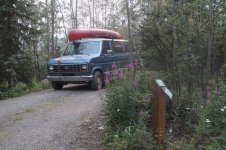
We pulled into our campsite at around seven-thirty. It had been a long, frustrating, worrisome day. We all rested comfortably. I’m thinking, though, that Shadow might be blaming me for having left him at the Tails and Trails Dog Hotel. He still won’t look at me when I call his name.
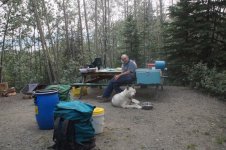
Shadow. Shadow. Shadow. Look at me when I call your name.
Friday, July 12. Up at 7:30 a.m. Cooked a hurried breakfast in a drizzling rain, packed up, and then drove to the town of Teslin for coffee and to check our emails. We then headed back out on the Alaska highway for 240 km (149 miles) before reaching the junction with the Stewart-Cassiar Highway. I braked only once in all that distance. Just as I was coming up behind a bicyclist on the edge of the highway, a vehicle pulled out into the oncoming lane to pass me—not enough room between the bicycle and the other vehicle for me to squeeze through.
For those of you who might not know, the Stewart-Cassiar Highway runs north/south in northwestern British Columbia for 725 km (450 miles). Along the way, at Meziadin Junction, you can turn west onto the Glacier Highway and drive only 66 km (41 miles) to Hyder, Alaska. Somewhat amusingly, a sign in front of a business at the north end of the Stewart-Cassiar Highway reads: “South to Alaska.” On one of our previous trips, when we reached the sign, Kathleen popped in a tape to hear Johnny Horton sing North to Alaska, as weheaded south to Alaska. The juxtaposition amused us at the time. Apparently we were way too easily amused.
(Listen to Johnny. https://www.youtube.com/watch?v=b3tAJS0wpRY)
The Stewart-Cassiar Highway is very winding and narrow. I actually had to brake four or five times before reaching our destination of Boya Lake Provincial Park in about another 120 km (75 miles).
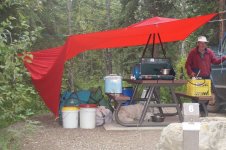
We had planned a short day, and set up camp just after three o’clock in typical British Columbia weather. Overcast, cool, and some drizzle, with a definite threat of rain. Despite what the mechanic in Whitehorse said, I was not really enjoying our “adventure” of driving through mountainous country knowing that a potential existed for my brakes to fail. And we still had 1,121 km (695 miles) to go to reach Prince George.
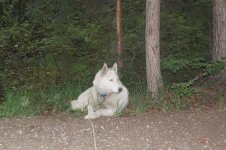
Shadow relaxing at Boya Lake Provincial Park.
We bought some wood from the camp attendant for an evening fire, which cheered me up a little bit, as we sipped the last of our white wine.
“I hope those flex hoses are actually at Canadian Tire when we get there, Kathleen. I’m optimistic, but not completely confident.”
“Well, Michael, you always gotta worry about something. We heard Stephen make the appointment for us in Prince George. We heard him say exactly what parts we needed. The hoses are bound to be there.”
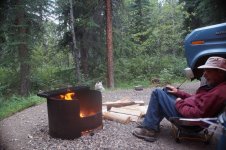
Me, somewhat relaxing at Boya Lake Provincial Park.
Saturday, July 13. I didn’t write much in my journal for today. Kathleen and I mostly just rolled along the highway, hoping to make it to Prince George. We passed by the “Check Brake Area” at the top of the five-kilometre (three miles) descent to the Stikine River. I could have pulled off to inspect the flex hoses for leaks, I suppose; but, I was worried about what I might find. Sort of like not wanting to schedule an annual physical checkup for fear of what the doctor might discover.
When we were leaving Canadian Tire in Whitehorse, Stephen said, “If your brakes go out, just hit the ditch.” Good advice, I suppose. Two things about that, though. First, hitting the ditch is not really in my skill set. Second, when descending steeply to the Stikine River, a ditch might not conveniently present itself when most needed. Rather, a precipitous side of a mountain might just replace the hoped for ditch. We headed down in first gear, much to the irritation of several vehicles unfortunate enough to be behind me. But we made it across the Stikine River without having to hit the ditch, or the side of the mountain.
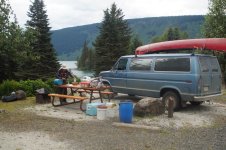
We stopped at the Meziadin Lake Provincial Park for the night. Only 638 km (395 miles) to Prince George, and those long sought-after flex hoses.
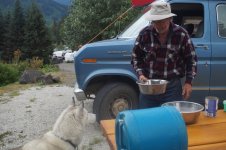
Time for Shadow's supper.
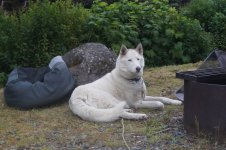
Hoping the flex hoses have arrived in Prince George.
Sunday, July 14. On the road at 9:00 a.m. We reached the southern junction of the Stewart-Cassiar Highway at Kitwanga, British Columbia at 11:15 a.m. Now only 486 km (301 miles) to Prince George. We stopped for gas and lunch at the gas station/restaurant/convenience store. I relaxed when we slid into the leather booth, knowing that we were off the Stewart-Cassiar Highway, which has very few services, and no cell service for the entire 725 km (450 miles). The largest community, Dease Lake, had only 303 people in 2011.
We had stopped in Dease Lake yesterday for coffee. A little like stepping back in time to see people making calls on public pay phones. It was only eleven o’clock, and the liquor outlet in the gas station/restaurant/grocery store didn’t open until noon. We were out of wine, but didn’t want to wait around for an hour. When paying for our coffee, Kathleen asked the cashier if there were any other liquor stores in Dease Lake.
“No, but let me help this customer, and I’ll go over and open up for you.” Sort of like living in Mayberry on the old Andy Griffith show.
After lunch, we drove east on Highway 16, a well-travelled road, with several communities along the way. We ended our day at a dog-friendly motel in Burns Lake, British Columbia. It had been raining off and on for most of the day, and camping didn’t appeal to us. Only 228 km (141 miles) to Prince George. We planned to arrive early in the afternoon tomorrow to see if Canadian Tire had those flex hoses. If the hoses were in, maybe they could be installed tomorrow, a Monday, even though our appointment was not until 7:30 a.m. on Tuesday. I was, on balance, optimistic that we would finally have flex hoses, and renewed confidence in our brakes.
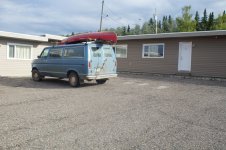
We stopped at a dog-friendly motel in Burns Lake, British Columbia.
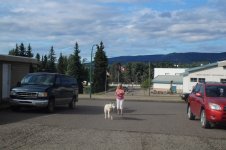
Monday, July 15. Morning walk in Burns Lake, British Columbia.
“Do you want to stop at the bistro to get a latte, Kathleen?”
“I don’t know. We need to get going.”
“It doesn’t take very long. You know you like to have a latte in the morning.”
“Yeah, I do. OK.”
So we drove down to the Riverwest Bistro on Front Street, where we stood in line to get a latte for Kathleen, and a coffee for me. Back in the van, we headed south down the north Klondike highway, hoping for the best. Hoping that our breaks didn’t go out. Hoping that we could get through the smoke. Although a lot of smoke shrouded the highway, other vehicles were coming north, and when we reached the spot predicted to most smoky, the pilot car was parked on the side of the road. So far, so good.

Fireweed blooming along the smoke-shrouded North Klondike Highway.
We stopped at the Coal Mine Campground, where we bought two “Klondike Quickies,” a great bacon/egg/cheese sandwich for only $6.00 each. A real bargain. A small dog trailed us down to the picnic table near the river—mooching all the way. He was out of luck, though. Kathleen and I don’t ever feed Shadow bites from our meals. And he’s our dog. He quickly learned that mooching doesn’t pay. Speaking of Shadow, the grand reunion was now only about two hours away.
Kathleen and I arrived at the Tails and Trails Dog Hotel at 2:15 p.m. Too early by forty-five minutes. Nina had said that we could pick Shadow up between three and six in the afternoon. We got out of the van anyway, and knocked on the office door. No answer. Dogs in their runs were going berserk. Shadow is a quiet dog, and rarely barks or gets overly excited. He just sat there, looking at us just like Dawn looked at us in the Northwest Territories Information Booth. He seemed to be thinking, “Who are these old people staring at me like I should know them?” After a few minutes, Shadow began to shift his weight back-and-forth, from one front foot to the other. Then he began to howl. It was beautiful to hear. Shadow certainly recognized us now.
“What should we do, Michael? I don’t want to just drive away. And we can’t just sit here doing nothing. I’m going to called Nina, and see if she can come early.”
Nina arrived 15 minutes later, and led us into the reception area. “Let me go get Shadow,” she said. “I’ll bring him out to you.”
Nina brought Shadow into the hallway, and he trotted toward Kathleen. He appeared uncertain. Then he turned and trotted back to Nina. He turned, and again approached Kathleen, somewhat cautiously. He turned his head to look back at Nina, and then finally ran up to Kathleen to bury his heads between her legs. Nina had cared for Shadow for 17 days, and she had gained his trust. That spoke well for Nina, and confirmed that Shadow had felt safe and secure at the Tails and Trails Dog Hotel.
Nina presented the invoice. “The total is $408.00, (17 days @ $24.00/day) minus a 10% discount for a stay longer than 14 days. This brings the final total to $367.20.”
“How ‘bout I write a cheque for $400.00?”
Nina’s eyes got big, just like Rainer’s eyes when we told him that we had paddled the Rock Gardens on the South Nahanni River.
“No one has ever tipped before.”
“Well, I tip wait staff 20% just for taking my order and bringing my plate. You looked after my dog every day. And you obviously did a great job.”
We loaded up all of Shadow’s stuff into the van, and he leaped in to curl up in his bed. Kathleen and I then drove the short distance to the Takhini Hot Springs Campground, where we enjoyed a celebratory glass of white wine before supper. Shadow looked very comfortable. Kathleen and I then strolled over to the hot pools for a relaxing soak, followed by an early bed time. All three of us us fell asleep, within touching distance, in the back of the van. It felt fantastic for the family to finally be all together again.

Takhini Springs Hot Pools, (From takhinihotsprings.com)
Thursday, July 11. After a very good sleep for all three of us, we drove into Whitehorse for a bagel and breakfast sandwich at Timmy’s at 8:00 a.m.We wanted to get an early start. We wanted to get the cracked flex hoses fixed as early in the day as possible. We wanted to get headed south to put in some distance.
After shopping for more groceries for the road trip, we drove the van into Canadian Tire’s service area at 9:45 a.m. I asked Stephen, the service representative, if he had a gas cap available. I had forgotten mine on the pump in Dawson City. Also told Stephen that my antifreeze was good only down to minus ten.
“Well, we do have a gas cap that fits your van. And we can flush the radiator for you.”
Shadow, Kathleen and I all sat down in the reception area, expecting to see eager mechanics sprinting toward our vehicle. Our expectation proved to be ill-founded. The van didn’t get lifted up on the hoist until 11:30 a.m. The only good aspect of this unwelcome wait, was that Shadow hadn’t flinched when new people came into his space. We tried to encourage him to leave the reception room, to venture into the main part of Canadian Tire. He wouldn’t leave the room though. Still not trusting new, large unknown, indoor spaces.
A couple of hours later, Stephen came with the bad news. “I’m afraid that the mechanic has confirmed that your flex hoses are cracked.”
“Yeah, we knew that. So can you replace them?”
“Not today. It would take five days to get new flex hoses.”
“That’s disappointing, Stephen. Is it safe to drive?”
“I wouldn’t drive it,” he said. “What would you like us to do?”
“I better talk to Kathleen.”
We faced about seven days of driving to get home to Preeceville. Adding another five days meant that we wouldn’t get home until around July 23. We had bed and breakfast guests booked for the night of July 20. We had to be home no later than July 19.
“So what should we do, Michael?”
“I don’t know, Kathleen. Maybe we could rent a U-Haul truck to get all our stuff home. I could then fly back to Whitehorse to get the van.”
“I don’t like that too much, Michael.”
“Neither do I. Let me go talk to Stephen again. He probably said it wasn’t safe to drive as a safety/liability thing.”
I went back to the service desk. “Is the van really unsafe to drive, Stephen?”
“Come on back with me. I’ll let you talk to the mechanic.”
So Stephen led me into the service area to meet the mechanic. The van was still up on the lift. He started twisting the left hose pretty dang harshly, I thought. “Hey, be careful. Don’t they already have cracks?”
“They’re supposed to twist,” he said.
I peered at the hose. “I don’t see any cracks.”
“They’re small. Do you carry vice grips? You should always carry vice grips in your vehicle.”
“I have vice grips in my canoe repair kit. What would I do with them?”
“If the hose starts to leak, just clamp it off with the grips. I’ll show you.”
“Well if I do that, won’t that stop brake fluid from getting to the wheel?
“”Yeah, but you would still have fluid going to the other three wheels. It wouldn’t leak out completely.”
“So would you drive this van with these cracked hoses?”
“Sure. You’ve already come 500 km from Dawson City. Why not go some more? Old-timers used to drive these roads in old cars with almost no services. You’ll have plenty of services along the way. Have an adventure.”
“OK. I think I’ll chance it.”
I walked back to Kathleen in the reception area, and told her what the mechanic said. “Why don’t you go ask Stephen if you can talk to the mechanic, and look at the flex hoses, Kathleen. See what you think.”
So Kathleen went to see Stephen, who didn’t let her go into the service area: Employees Only. She came back to report that Stephen told her, “You’re more likely to hit a moose or bison, than your brakes will fail.”
So that settled it. We’re going to chance driving home. When I went to sign the papers, I pointed out to Stephen that he was much more optimistic with Kathleen than he was with me.
“I just told her that to make her feel better. ”
“You shouldn’t have told me that, Stephen. You’re not making me feel any better. I think we are gonna go though. We plan to go down the Stewart-Cassiar highway, which doesn’t have quite so many steep and long hills as the Alaska Highway. I think there’s only a couple of spots where the grades are as much as eight percent. We’ll be going through Prince George. Do you think the Canadian Tire there could get replacement flex hoses?”
“Yeah, they can,” Stephen said. “Prince George has five suppliers in town. They can easily get your parts.” Stephen called Prince George to make an appointment for us at 7:30 a.m. for next Tuesday. he also told them what parts we needed for the flex hoses and the blower motor.
“I don’t think we’ll wait to flush the radiator, Stephen. We can do that in Prince George.” I paid for the brake check and the replacement gas cap, and we headed over to Timmy’s for an apple fritter. We badly needed some comfort food.
It’s only 1,619 km (1,004 miles) to Prince George. I planned to go easy on my brakes. Gear down when necessary. Slow down well ahead of turns on the highway. And, as I learned, I didn’t actually have to brake all that often. In fact, I used the brakes only once in nearly 160 km (99 miles) between Whitehorse and the Teslin Lake campground, where we stopped for the night. And even then, I braked only because someone ahead of me was turning left off the narrow highway that had only one lane each way. It turns out that you don’t need brakes if you never use them. Who knew?

We pulled into our campsite at around seven-thirty. It had been a long, frustrating, worrisome day. We all rested comfortably. I’m thinking, though, that Shadow might be blaming me for having left him at the Tails and Trails Dog Hotel. He still won’t look at me when I call his name.

Shadow. Shadow. Shadow. Look at me when I call your name.
Friday, July 12. Up at 7:30 a.m. Cooked a hurried breakfast in a drizzling rain, packed up, and then drove to the town of Teslin for coffee and to check our emails. We then headed back out on the Alaska highway for 240 km (149 miles) before reaching the junction with the Stewart-Cassiar Highway. I braked only once in all that distance. Just as I was coming up behind a bicyclist on the edge of the highway, a vehicle pulled out into the oncoming lane to pass me—not enough room between the bicycle and the other vehicle for me to squeeze through.
For those of you who might not know, the Stewart-Cassiar Highway runs north/south in northwestern British Columbia for 725 km (450 miles). Along the way, at Meziadin Junction, you can turn west onto the Glacier Highway and drive only 66 km (41 miles) to Hyder, Alaska. Somewhat amusingly, a sign in front of a business at the north end of the Stewart-Cassiar Highway reads: “South to Alaska.” On one of our previous trips, when we reached the sign, Kathleen popped in a tape to hear Johnny Horton sing North to Alaska, as weheaded south to Alaska. The juxtaposition amused us at the time. Apparently we were way too easily amused.
(Listen to Johnny. https://www.youtube.com/watch?v=b3tAJS0wpRY)
The Stewart-Cassiar Highway is very winding and narrow. I actually had to brake four or five times before reaching our destination of Boya Lake Provincial Park in about another 120 km (75 miles).

We had planned a short day, and set up camp just after three o’clock in typical British Columbia weather. Overcast, cool, and some drizzle, with a definite threat of rain. Despite what the mechanic in Whitehorse said, I was not really enjoying our “adventure” of driving through mountainous country knowing that a potential existed for my brakes to fail. And we still had 1,121 km (695 miles) to go to reach Prince George.

Shadow relaxing at Boya Lake Provincial Park.
We bought some wood from the camp attendant for an evening fire, which cheered me up a little bit, as we sipped the last of our white wine.
“I hope those flex hoses are actually at Canadian Tire when we get there, Kathleen. I’m optimistic, but not completely confident.”
“Well, Michael, you always gotta worry about something. We heard Stephen make the appointment for us in Prince George. We heard him say exactly what parts we needed. The hoses are bound to be there.”

Me, somewhat relaxing at Boya Lake Provincial Park.
Saturday, July 13. I didn’t write much in my journal for today. Kathleen and I mostly just rolled along the highway, hoping to make it to Prince George. We passed by the “Check Brake Area” at the top of the five-kilometre (three miles) descent to the Stikine River. I could have pulled off to inspect the flex hoses for leaks, I suppose; but, I was worried about what I might find. Sort of like not wanting to schedule an annual physical checkup for fear of what the doctor might discover.
When we were leaving Canadian Tire in Whitehorse, Stephen said, “If your brakes go out, just hit the ditch.” Good advice, I suppose. Two things about that, though. First, hitting the ditch is not really in my skill set. Second, when descending steeply to the Stikine River, a ditch might not conveniently present itself when most needed. Rather, a precipitous side of a mountain might just replace the hoped for ditch. We headed down in first gear, much to the irritation of several vehicles unfortunate enough to be behind me. But we made it across the Stikine River without having to hit the ditch, or the side of the mountain.

We stopped at the Meziadin Lake Provincial Park for the night. Only 638 km (395 miles) to Prince George, and those long sought-after flex hoses.

Time for Shadow's supper.

Hoping the flex hoses have arrived in Prince George.
Sunday, July 14. On the road at 9:00 a.m. We reached the southern junction of the Stewart-Cassiar Highway at Kitwanga, British Columbia at 11:15 a.m. Now only 486 km (301 miles) to Prince George. We stopped for gas and lunch at the gas station/restaurant/convenience store. I relaxed when we slid into the leather booth, knowing that we were off the Stewart-Cassiar Highway, which has very few services, and no cell service for the entire 725 km (450 miles). The largest community, Dease Lake, had only 303 people in 2011.
We had stopped in Dease Lake yesterday for coffee. A little like stepping back in time to see people making calls on public pay phones. It was only eleven o’clock, and the liquor outlet in the gas station/restaurant/grocery store didn’t open until noon. We were out of wine, but didn’t want to wait around for an hour. When paying for our coffee, Kathleen asked the cashier if there were any other liquor stores in Dease Lake.
“No, but let me help this customer, and I’ll go over and open up for you.” Sort of like living in Mayberry on the old Andy Griffith show.
After lunch, we drove east on Highway 16, a well-travelled road, with several communities along the way. We ended our day at a dog-friendly motel in Burns Lake, British Columbia. It had been raining off and on for most of the day, and camping didn’t appeal to us. Only 228 km (141 miles) to Prince George. We planned to arrive early in the afternoon tomorrow to see if Canadian Tire had those flex hoses. If the hoses were in, maybe they could be installed tomorrow, a Monday, even though our appointment was not until 7:30 a.m. on Tuesday. I was, on balance, optimistic that we would finally have flex hoses, and renewed confidence in our brakes.

We stopped at a dog-friendly motel in Burns Lake, British Columbia.

Monday, July 15. Morning walk in Burns Lake, British Columbia.
Attachments
Last edited:
Your journey and story just keeps getting better and better. Thanks PaddlingPitt.
Last edited:
Monday, July 15. We stopped at Timmy’s in Vanderhoof, British Columbia for a latte, an ice cappuccino and toasted bagels. Only 97 km (60 miles) from Prince George. We should be only one hour away from those flex hoses; but, I’m beginning to worry again.
We arrived at Canadian Tire around one o’clock, and strolled up to the service desk, where we met Alexis, a very pleasant young woman.
“We have an appointment for seven-thirty tomorrow morning, but we’re wondering if we could get the work done today.”
“Let me just check,” Alexis said, as she keyed into her computer. “Yes, I have you here, and I see you have had some work done recently in Whitehorse. But I don’t have any information about the work you want done.”
“We’re supposed to get new flex hoses for our front wheels, and a blower motor. Also, we would like the radiator to be flushed. Do you have the flex hoses in?”
“No we don’t. Nothing’s been ordered.”
I felt somewhat speechless, if not entirely surprised. “Can you get the parts here in town?”
“We could, but they’re more expensive than our suppliers in Vancouver. They can get them here by ten tomorrow morning.”
I didn’t like this too much. “I prefer that we can get the work started at seven-thirty. I don’t really care about the higher price.”
Alexis called over to the Ford dealership in town.
“Sorry, they don’t have the parts. We’ll have to order from Vancouver. We don’t actually start working at seven-thirty anyway. We open at seven-thirty. We start working at eight. But while we’re waiting for the parts tomorrow, we can start flushing the radiator. That will save you some time.”
“Well, ok. Do you mind calling Stephen in Whitehorse? Maybe he remembers who he talked to here. Maybe that person ordered the parts, and they are sitting around here somewhere.”
Alexis called Stephen, who didn’t remember who he talked to. “Besides,” she said. “If someone had ordered parts, I would have a record of it. Do you want me to order the parts for you. I guarantee they will be here by ten.”
“OK. Do you know of a nearby dog-friendly motel?”
“Yep. The Bon Voyage. It’s only a few minutes away.”
So all three of us drove over, and checked into the Bon Voyage, which was in a little mall that included a pizza outlet. That sounded great to us. According to the information in our hotel room, the pizza place opened at four. We showed up at 4:15 to read that they were closed on Mondays. Our day wasn’t getting any better. We returned to our room, and ordered in a pizza. The pizza was almost pretty good. Our day still wasn’t getting any better. And, the WiFi in our room worked only intermittently. Maybe our fortunes will improve tomorrow. I was not optimistic, however.
I drank a lot of red wine with almost pretty good pizza.
“You know, Kathleen, I don’t really need to get up early, pack up the van, and drive over at seven-thirty. They don’t actually start working until eight.”
“Michael, I think you should get there by seven forty-five at the latest to make sure they start flushing the radiator while waiting for the parts. Alexis said that would save us some time.”
“I know, but I don’t actually trust them to do the work.”
“That’s why you have to go. To make sure they follow through, Michael.”
I woke up at two in the morning, and couldn’t fall back to sleep. Had a glass of wine. Then another. Still couldn’t sleep. Poured a third glass of wine. Kathleen stirred from her side of the bed.
“What are you doing, Michael? If you get stopped, and are over the limit, I’ll have to drive home!”
Kathleen was right. That would be real bad news. I’m a terrible passenger. I slept fitfully until six-thirty.
Tuesday, July 16. I got up, dressed quickly, and strolled over to the restaurant, where I rushed through my complimentary breakfast of juice, coffee, toast and English muffin. Back at the hotel room, Kathleen and Shadow were still sleeping. No need for them to get up, as they wouldn’t be joining me at Canadian Tire just to wait for the parts to arrive. After breakfast, I packed the van, kissed Kathleen and petted Shadow goodby, and drove over to Canadian Tire. The service centre was empty. All was very quiet. Too quiet for my liking.
Finally, mechanic-looking-kind-of-guys started to wander in. I texted progress to Kathleen. “Van went in at 8:06 a.m. Hood up at 8:07 a.m. Hoisted up on the rack at 8:19 a.m. Tires are off. This all looks good. No sign of radiator flushing, though.”
The blower motor from NAPA Auto Parts arrived just after ten. The flex hoses from Lordco Auto Parts showed up eighteen minutes later. But whose keeping track? Well, that would be me keeping track.
Work on the van began about 30 minutes later. Kathleen and Shadow checked out of the hotel, and walked over to Canadian Tire, arriving about eleven-fifteen.
“You know, Michael, when Shadow and I were leaving the hotel, a little boy, about nine or ten was coming down the stairs, and saw Shadow. He said, ‘Look, Mommy. A wolf.’ It’s not a wolf, I told him. It’s a Siberian husky. ‘It’s wolf,’ he said, and ran back up the stairs.”
A little before noon the blower motor and flex hoses seemed to have been installed. But the hood was still up, and all the mechanics were gone. I strolled over to the service desk. “So Alexis. Is the van just about ready to go?”
“Just about. But the mechanics are having lunch now.”
“Alexis, maybe I’ll just get the radiator flushed when I get home. We gotta get going”
Alexis went off to check with the mechanic.
“He says that the flushing started a few minutes ago, and would take only another 30 minutes after he returns. You might as well wait.”
I sat back down next to Kathleen in the reception area. “Driving the van over at seven forty-five, Kathleen, was a waste of my morning. I could have enjoyed breakfast.”
I tried to relax, but felt quite impatient and glum. After the radiator flushing was complete, Alexis reported that the mechanic said that “The blower motor works only on high. He can do some testing to find the problem, if you like.”
“No we can do that when we get home. We gotta get going.”
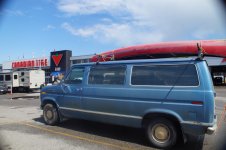
We finally left Canadian Tire a little before two in the afternoon. We drove only 208 km (129 miles) to McBride, British Columbia, a small community nestled in a beautiful, green valley at the foot of the Rocky Mountains. We checked into a tired looking Sandman Inn at five. Disappointed but not surprised that the WiFi didn’t work unless we stood out in the hall. Shadow showed a lot of confidence, though, by strutting into the lobby and strolling casually down the hall to our room. We dined on chicken with macaroni salad in our room for supper.
Still a long way to get home to Preeceville: 1,345 km (834 miles). But at least we had brakes, now. Or so I believed. We planned to go about halfway, and stay overnight at the Innisfree Municipal Recreation Park in Alberta. We intended to get an early start.
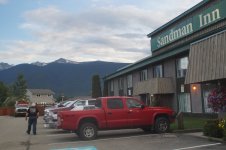
Sandman Inn, McBride, British Columbia
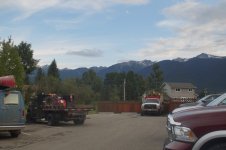
McBride. Picturesque valley at the foot of the Rocky Mountains
Wednesday, July 17. We woke at five-thirty to the sound of a soft rain. Sat down in the restaurant at six forty-five, where we both ordered the $7.95 breakfast special: two eggs, sausage, toast and hash browns. Way too much to eat. We pulled out onto the road a little after eight.
Like yesterday afternoon, I enjoyed my renewed confidence in the van. I headed downhill with speed. I sometimes even braked into turns, despite having learned since leaving Whitehorse that slowing down before the turn is actually a better choice.
On a whim, we stopped briefly in Jasper National Park, hoping to visit our friend Alan, who is the park’s superintendent. Unfortunately, we just missed him.
We next stopped in Hinton, Alberta, at Timmy’s for bagels, a latte, and an ice cappuccino. As always, though, we first let Shadow out of the van. Before his stay at the Tails and Trails Dog Hotel, Shadow always did his business quickly, and then raced back to the van. Since his stay at the hotel, though, he has wandered, then peed, and then explored. He is so much more confident. He even now often marks during his wanders. He virtually never marked before staying at the Tails and Trails Dog Hotel.
After leaving Hinton, we enjoyed a divided, double-lane highway. Very easy driving until we approached Edmonton, Alberta—during rush hour, of course. I pulled off the highway, looking for gas in Spruce Grove, 11 km (6 miles) west of Edmonton. According to an internet search, we believed the gas station to be on the left side of the road, but it suddenly appeared on the right. I signalled to change lanes, which was probably a mistake. Vehicles in the right lane now sped up to prevent me from moving over. Cars behind me in my lane honked out their anger.
Back on the highway, we crawled very slowly with the multiple lanes of traffic heading east. “You know, Kathleen, I’m sorry I ever complained about those headwinds on the Yukon River.”
Near Vegreville, Alberta, the highway was closed because of an accident. I wondered how that could be. There were two divided lanes in both directions. The road was straight. The traffic was very light. We seemed to be driving all on our own for much of the time. Perhaps someone had just become inattentive.
I was glad for the detour through Vegreville that took us off the highway, and around the accident. I still have very vivid memories of an accident that I drove by on the freeway near Salt Lake City in 1968. It was Christmas, and colourful presents lay strewn around two mangled, upturned cars. A little boy sat on the pavement in the middle of the carnage, looking horribly bewildered as cars crept by on either side. I could never be a first responder. I could never be any kind of responder. I would dread the prospect.
We parked at our traditional campsite number 13 at the Innisfree Municipal Recreation Park at six forty-five—reasonably early considering that we lost an hour with the time change. We will probably make it home tomorrow in the early evening.
Thursday, July 18. It rained for most of the night, but stopped by six in the morning. “Do you want me to make tea, Kathleen?”
“No. Let’s just pack up and go.”
On the road by seven. Fifty kilometres (30 miles) later we stopped in Vermillion, Alberta at Timmy’s for breakfast and the free WiFi. The weather report predicted tornados and severe thunder storms for the afternoon. That was good. Now I had something to worry about again.
At eleven-thirty, we drove off the highway into Radisson, Alberta, which is a very small town. So small it didn’t even have a Timmys. Imagine that. After letting Shadow out to pee and explore, we went to the cafe for lunch. It was a Chinese/Canadian cafe. Seemingly, all cafes in rural Saskatchewan are Chinese owned. An older lady, sitting across the room asked, “Where are you from?”
“Preeceville.”
“Oh, Yeah.”
“You know it?”
“Not really. Is it bigger than here? We have four hundred people.”
“Preeceville is about 1,200 people. Bigger than it has ever been. But that’s only because older farmers are moving into town. Not nearly as many people living out on the land anymore. Retail outlets are closing. These small rural towns are all dying. Sad to see.”
The older lady nodded in agreement.
Kathleen and I ordered mushroom fried noodles to share. Truly excellent.
We then walked across the street to get cash from the Canadian Imperial Bank of Commerce. A sign on the door read “Last Day. Closing Forever at 3:00 p.m.” Sad to see.
Back in the van, we ran before an angry sky all afternoon. We stopped at Timmy’s in Humboldt, Saskatchewan, and read that tornados and severe thunderstorms were still predicted for the afternoon. We stopped at Wadena, Saskatchewan for gas. One hour to go. It seemed like we had been on the road forever. I hardly even remembered being on the Yukon River.
We reached home about six. Shadow seemed overjoyed. He ran and bounded in circles when he catapulted out of the van. We briefly inspected our three vegetable gardens. The weeds had done very well in our absence. About 50-60 pocket gopher mounds littered the landscape. dang! I thought I had trapped them all out.
As expected, we had come home to many accumulated chores. We also had bed & breakfast guests arriving in two days. So much to do.
Kathleen and I went inside our house to rest, to share a glass of wine or two, and to reflect on our Yukon River adventure.
Postscript
Kathleen and I had spent 17 days and 7,250 km (4,500 miles) on the road to live only 14 days on the Yukon River. Was it worth it, some might ask. What a silly question, though. I apologize for putting words in your mouth. Kathleen and I are northern river canoeists. Of course it was worth it. Besides, the road trip was an integral part of the adventure, and will certainly provide many lasting memories.
You might be wondering about the outcome of the Yukon River Quest. The following is from the Yukon River Quest News, on July 2, 2019.
Teams were beset with several challenges this year: the river was low for the third straight year (in fact it was the lowest we have seen in 21 years); strong northwest head winds generated by a squall on Lake Laberge flipped one team (all were helped to shore and then carried on) and forced others teams to pull over and bail their boats; more head winds downriver of Fort Selkirk all the way to Dawson City; and some smoke from forest fires in the Stewart-Dawson area. As a result, winning times in the various classes were quite a bit slower this year. Only 9 teams finished on Friday evening in under 50 hours.
That’s very impressive. Nine teams completed 715 km (443 miles) in under 50 hours, not counting the mandatory layovers in Carmacks and Coffee Creek. And all, while battling strong headwinds, aided by a current slower than normal. You gotta tip your hat to them.
Kathleen and I are now deciding where to go next. As you might remember, we thought it might be nice to go on a guided trip, and let someone else, like Rainer Russmann, of Yukon Wild, do all the work.
We looked at Rainer’s webpage, and saw that he offers trips on the Blackstone River, down to the Peel River, above the Aberdeen Canyon. The Blackstone River had always appealed to me, except for the part about having to portage as much as 10 km (six miles) around Aberdeen Canyon. Rainer’s trip though, flies home before the portage. Maybe we should book that trip, we thought.
Rainer lists the trip at $5,500 Canadian per person, for a total cost to me and Kathleen of $11,000 Canadian (about $8,250 U.S.) That’s a lot of money, for less than two weeks of actually being on the river. Of course, that includes float plane flights, some accommodation, all you can eat, and the sheer joy of watching Rainer doing all the work. But still, that’s a lot of money.
But we have to spend a lot of money, and time, no matter what trip we pursue. Our preference is to be in the far north, certainly north of sixty degrees, and preferably north of the Arctic Circle. When we reflect on our wilderness canoe trips, our favourite was the Thelon River, in 1993, when we paddled east for 37 days and 950 km (590 miles) from the outlet of Lynx Lake down to Baker Lake at the head of Chesterfield Inlet on Hudson Bay.
Several rivers are tied for our second favourite trip. But we very much enjoyed our adventure in 2001, when we flew back to Lynx Lake, and then paddled west to Whitefish Lake, and then portaged over the height of land to the Snowdrift River, which carried us back toward Great Slave Lake.
These northern trips both featured nearly constant daylight and the spectacular scenery and isolation of the Barren Grounds. This is what we seek. So our plan now is to fly to the western edge of Whitefish Lake, and then paddle back toward the eastern edge of Lynx Lake. We might not even make it that far. We might just find a few spots that we like, and set up base camps. We are getting older. We no longer feel the need break camp every day just to cover more distance. How much will it cost? Kathleen says it doesn’t make any difference. It’s what we want to do.
I will eventually be sharing theseThelon and Snowdrift trips on the canoetripping.net website. Until then, let me leave you with these four images of our Thelon and Snowdrift River trips. We hope to return next summer.
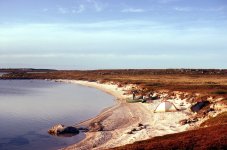
Outlet of Lynx Lake, to the Thelon River
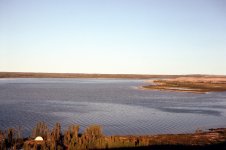
Thelon River below confluence with the Elk River
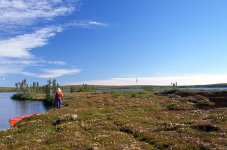
Looking toward Whitefish Lake
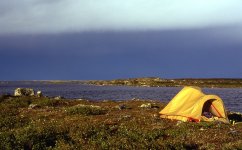
Whitefish Lake camp.
We arrived at Canadian Tire around one o’clock, and strolled up to the service desk, where we met Alexis, a very pleasant young woman.
“We have an appointment for seven-thirty tomorrow morning, but we’re wondering if we could get the work done today.”
“Let me just check,” Alexis said, as she keyed into her computer. “Yes, I have you here, and I see you have had some work done recently in Whitehorse. But I don’t have any information about the work you want done.”
“We’re supposed to get new flex hoses for our front wheels, and a blower motor. Also, we would like the radiator to be flushed. Do you have the flex hoses in?”
“No we don’t. Nothing’s been ordered.”
I felt somewhat speechless, if not entirely surprised. “Can you get the parts here in town?”
“We could, but they’re more expensive than our suppliers in Vancouver. They can get them here by ten tomorrow morning.”
I didn’t like this too much. “I prefer that we can get the work started at seven-thirty. I don’t really care about the higher price.”
Alexis called over to the Ford dealership in town.
“Sorry, they don’t have the parts. We’ll have to order from Vancouver. We don’t actually start working at seven-thirty anyway. We open at seven-thirty. We start working at eight. But while we’re waiting for the parts tomorrow, we can start flushing the radiator. That will save you some time.”
“Well, ok. Do you mind calling Stephen in Whitehorse? Maybe he remembers who he talked to here. Maybe that person ordered the parts, and they are sitting around here somewhere.”
Alexis called Stephen, who didn’t remember who he talked to. “Besides,” she said. “If someone had ordered parts, I would have a record of it. Do you want me to order the parts for you. I guarantee they will be here by ten.”
“OK. Do you know of a nearby dog-friendly motel?”
“Yep. The Bon Voyage. It’s only a few minutes away.”
So all three of us drove over, and checked into the Bon Voyage, which was in a little mall that included a pizza outlet. That sounded great to us. According to the information in our hotel room, the pizza place opened at four. We showed up at 4:15 to read that they were closed on Mondays. Our day wasn’t getting any better. We returned to our room, and ordered in a pizza. The pizza was almost pretty good. Our day still wasn’t getting any better. And, the WiFi in our room worked only intermittently. Maybe our fortunes will improve tomorrow. I was not optimistic, however.
I drank a lot of red wine with almost pretty good pizza.
“You know, Kathleen, I don’t really need to get up early, pack up the van, and drive over at seven-thirty. They don’t actually start working until eight.”
“Michael, I think you should get there by seven forty-five at the latest to make sure they start flushing the radiator while waiting for the parts. Alexis said that would save us some time.”
“I know, but I don’t actually trust them to do the work.”
“That’s why you have to go. To make sure they follow through, Michael.”
I woke up at two in the morning, and couldn’t fall back to sleep. Had a glass of wine. Then another. Still couldn’t sleep. Poured a third glass of wine. Kathleen stirred from her side of the bed.
“What are you doing, Michael? If you get stopped, and are over the limit, I’ll have to drive home!”
Kathleen was right. That would be real bad news. I’m a terrible passenger. I slept fitfully until six-thirty.
Tuesday, July 16. I got up, dressed quickly, and strolled over to the restaurant, where I rushed through my complimentary breakfast of juice, coffee, toast and English muffin. Back at the hotel room, Kathleen and Shadow were still sleeping. No need for them to get up, as they wouldn’t be joining me at Canadian Tire just to wait for the parts to arrive. After breakfast, I packed the van, kissed Kathleen and petted Shadow goodby, and drove over to Canadian Tire. The service centre was empty. All was very quiet. Too quiet for my liking.
Finally, mechanic-looking-kind-of-guys started to wander in. I texted progress to Kathleen. “Van went in at 8:06 a.m. Hood up at 8:07 a.m. Hoisted up on the rack at 8:19 a.m. Tires are off. This all looks good. No sign of radiator flushing, though.”
The blower motor from NAPA Auto Parts arrived just after ten. The flex hoses from Lordco Auto Parts showed up eighteen minutes later. But whose keeping track? Well, that would be me keeping track.
Work on the van began about 30 minutes later. Kathleen and Shadow checked out of the hotel, and walked over to Canadian Tire, arriving about eleven-fifteen.
“You know, Michael, when Shadow and I were leaving the hotel, a little boy, about nine or ten was coming down the stairs, and saw Shadow. He said, ‘Look, Mommy. A wolf.’ It’s not a wolf, I told him. It’s a Siberian husky. ‘It’s wolf,’ he said, and ran back up the stairs.”
A little before noon the blower motor and flex hoses seemed to have been installed. But the hood was still up, and all the mechanics were gone. I strolled over to the service desk. “So Alexis. Is the van just about ready to go?”
“Just about. But the mechanics are having lunch now.”
“Alexis, maybe I’ll just get the radiator flushed when I get home. We gotta get going”
Alexis went off to check with the mechanic.
“He says that the flushing started a few minutes ago, and would take only another 30 minutes after he returns. You might as well wait.”
I sat back down next to Kathleen in the reception area. “Driving the van over at seven forty-five, Kathleen, was a waste of my morning. I could have enjoyed breakfast.”
I tried to relax, but felt quite impatient and glum. After the radiator flushing was complete, Alexis reported that the mechanic said that “The blower motor works only on high. He can do some testing to find the problem, if you like.”
“No we can do that when we get home. We gotta get going.”

We finally left Canadian Tire a little before two in the afternoon. We drove only 208 km (129 miles) to McBride, British Columbia, a small community nestled in a beautiful, green valley at the foot of the Rocky Mountains. We checked into a tired looking Sandman Inn at five. Disappointed but not surprised that the WiFi didn’t work unless we stood out in the hall. Shadow showed a lot of confidence, though, by strutting into the lobby and strolling casually down the hall to our room. We dined on chicken with macaroni salad in our room for supper.
Still a long way to get home to Preeceville: 1,345 km (834 miles). But at least we had brakes, now. Or so I believed. We planned to go about halfway, and stay overnight at the Innisfree Municipal Recreation Park in Alberta. We intended to get an early start.

Sandman Inn, McBride, British Columbia

McBride. Picturesque valley at the foot of the Rocky Mountains
Wednesday, July 17. We woke at five-thirty to the sound of a soft rain. Sat down in the restaurant at six forty-five, where we both ordered the $7.95 breakfast special: two eggs, sausage, toast and hash browns. Way too much to eat. We pulled out onto the road a little after eight.
Like yesterday afternoon, I enjoyed my renewed confidence in the van. I headed downhill with speed. I sometimes even braked into turns, despite having learned since leaving Whitehorse that slowing down before the turn is actually a better choice.
On a whim, we stopped briefly in Jasper National Park, hoping to visit our friend Alan, who is the park’s superintendent. Unfortunately, we just missed him.
We next stopped in Hinton, Alberta, at Timmy’s for bagels, a latte, and an ice cappuccino. As always, though, we first let Shadow out of the van. Before his stay at the Tails and Trails Dog Hotel, Shadow always did his business quickly, and then raced back to the van. Since his stay at the hotel, though, he has wandered, then peed, and then explored. He is so much more confident. He even now often marks during his wanders. He virtually never marked before staying at the Tails and Trails Dog Hotel.
After leaving Hinton, we enjoyed a divided, double-lane highway. Very easy driving until we approached Edmonton, Alberta—during rush hour, of course. I pulled off the highway, looking for gas in Spruce Grove, 11 km (6 miles) west of Edmonton. According to an internet search, we believed the gas station to be on the left side of the road, but it suddenly appeared on the right. I signalled to change lanes, which was probably a mistake. Vehicles in the right lane now sped up to prevent me from moving over. Cars behind me in my lane honked out their anger.
Back on the highway, we crawled very slowly with the multiple lanes of traffic heading east. “You know, Kathleen, I’m sorry I ever complained about those headwinds on the Yukon River.”
Near Vegreville, Alberta, the highway was closed because of an accident. I wondered how that could be. There were two divided lanes in both directions. The road was straight. The traffic was very light. We seemed to be driving all on our own for much of the time. Perhaps someone had just become inattentive.
I was glad for the detour through Vegreville that took us off the highway, and around the accident. I still have very vivid memories of an accident that I drove by on the freeway near Salt Lake City in 1968. It was Christmas, and colourful presents lay strewn around two mangled, upturned cars. A little boy sat on the pavement in the middle of the carnage, looking horribly bewildered as cars crept by on either side. I could never be a first responder. I could never be any kind of responder. I would dread the prospect.
We parked at our traditional campsite number 13 at the Innisfree Municipal Recreation Park at six forty-five—reasonably early considering that we lost an hour with the time change. We will probably make it home tomorrow in the early evening.
Thursday, July 18. It rained for most of the night, but stopped by six in the morning. “Do you want me to make tea, Kathleen?”
“No. Let’s just pack up and go.”
On the road by seven. Fifty kilometres (30 miles) later we stopped in Vermillion, Alberta at Timmy’s for breakfast and the free WiFi. The weather report predicted tornados and severe thunder storms for the afternoon. That was good. Now I had something to worry about again.
At eleven-thirty, we drove off the highway into Radisson, Alberta, which is a very small town. So small it didn’t even have a Timmys. Imagine that. After letting Shadow out to pee and explore, we went to the cafe for lunch. It was a Chinese/Canadian cafe. Seemingly, all cafes in rural Saskatchewan are Chinese owned. An older lady, sitting across the room asked, “Where are you from?”
“Preeceville.”
“Oh, Yeah.”
“You know it?”
“Not really. Is it bigger than here? We have four hundred people.”
“Preeceville is about 1,200 people. Bigger than it has ever been. But that’s only because older farmers are moving into town. Not nearly as many people living out on the land anymore. Retail outlets are closing. These small rural towns are all dying. Sad to see.”
The older lady nodded in agreement.
Kathleen and I ordered mushroom fried noodles to share. Truly excellent.
We then walked across the street to get cash from the Canadian Imperial Bank of Commerce. A sign on the door read “Last Day. Closing Forever at 3:00 p.m.” Sad to see.
Back in the van, we ran before an angry sky all afternoon. We stopped at Timmy’s in Humboldt, Saskatchewan, and read that tornados and severe thunderstorms were still predicted for the afternoon. We stopped at Wadena, Saskatchewan for gas. One hour to go. It seemed like we had been on the road forever. I hardly even remembered being on the Yukon River.
We reached home about six. Shadow seemed overjoyed. He ran and bounded in circles when he catapulted out of the van. We briefly inspected our three vegetable gardens. The weeds had done very well in our absence. About 50-60 pocket gopher mounds littered the landscape. dang! I thought I had trapped them all out.
As expected, we had come home to many accumulated chores. We also had bed & breakfast guests arriving in two days. So much to do.
Kathleen and I went inside our house to rest, to share a glass of wine or two, and to reflect on our Yukon River adventure.
Postscript
Kathleen and I had spent 17 days and 7,250 km (4,500 miles) on the road to live only 14 days on the Yukon River. Was it worth it, some might ask. What a silly question, though. I apologize for putting words in your mouth. Kathleen and I are northern river canoeists. Of course it was worth it. Besides, the road trip was an integral part of the adventure, and will certainly provide many lasting memories.
You might be wondering about the outcome of the Yukon River Quest. The following is from the Yukon River Quest News, on July 2, 2019.
Teams were beset with several challenges this year: the river was low for the third straight year (in fact it was the lowest we have seen in 21 years); strong northwest head winds generated by a squall on Lake Laberge flipped one team (all were helped to shore and then carried on) and forced others teams to pull over and bail their boats; more head winds downriver of Fort Selkirk all the way to Dawson City; and some smoke from forest fires in the Stewart-Dawson area. As a result, winning times in the various classes were quite a bit slower this year. Only 9 teams finished on Friday evening in under 50 hours.
That’s very impressive. Nine teams completed 715 km (443 miles) in under 50 hours, not counting the mandatory layovers in Carmacks and Coffee Creek. And all, while battling strong headwinds, aided by a current slower than normal. You gotta tip your hat to them.
Kathleen and I are now deciding where to go next. As you might remember, we thought it might be nice to go on a guided trip, and let someone else, like Rainer Russmann, of Yukon Wild, do all the work.
We looked at Rainer’s webpage, and saw that he offers trips on the Blackstone River, down to the Peel River, above the Aberdeen Canyon. The Blackstone River had always appealed to me, except for the part about having to portage as much as 10 km (six miles) around Aberdeen Canyon. Rainer’s trip though, flies home before the portage. Maybe we should book that trip, we thought.
Rainer lists the trip at $5,500 Canadian per person, for a total cost to me and Kathleen of $11,000 Canadian (about $8,250 U.S.) That’s a lot of money, for less than two weeks of actually being on the river. Of course, that includes float plane flights, some accommodation, all you can eat, and the sheer joy of watching Rainer doing all the work. But still, that’s a lot of money.
But we have to spend a lot of money, and time, no matter what trip we pursue. Our preference is to be in the far north, certainly north of sixty degrees, and preferably north of the Arctic Circle. When we reflect on our wilderness canoe trips, our favourite was the Thelon River, in 1993, when we paddled east for 37 days and 950 km (590 miles) from the outlet of Lynx Lake down to Baker Lake at the head of Chesterfield Inlet on Hudson Bay.
Several rivers are tied for our second favourite trip. But we very much enjoyed our adventure in 2001, when we flew back to Lynx Lake, and then paddled west to Whitefish Lake, and then portaged over the height of land to the Snowdrift River, which carried us back toward Great Slave Lake.
These northern trips both featured nearly constant daylight and the spectacular scenery and isolation of the Barren Grounds. This is what we seek. So our plan now is to fly to the western edge of Whitefish Lake, and then paddle back toward the eastern edge of Lynx Lake. We might not even make it that far. We might just find a few spots that we like, and set up base camps. We are getting older. We no longer feel the need break camp every day just to cover more distance. How much will it cost? Kathleen says it doesn’t make any difference. It’s what we want to do.
I will eventually be sharing theseThelon and Snowdrift trips on the canoetripping.net website. Until then, let me leave you with these four images of our Thelon and Snowdrift River trips. We hope to return next summer.

Outlet of Lynx Lake, to the Thelon River

Thelon River below confluence with the Elk River

Looking toward Whitefish Lake

Whitefish Lake camp.
Last edited:
Dear M&K,
You're not ready yet. You two still look a long ways off the rocking chairs by the fire thing, and if this past Yukon trip is anything to go by you won't be settling in to those rocking chairs for some time yet. But it was a nice taste of "slowing down" for you two, thanks for taking us along for the ride! And long may your van run.
https://www.youtube.com/watch?v=nszR0tfp4Es
You're not ready yet. You two still look a long ways off the rocking chairs by the fire thing, and if this past Yukon trip is anything to go by you won't be settling in to those rocking chairs for some time yet. But it was a nice taste of "slowing down" for you two, thanks for taking us along for the ride! And long may your van run.
https://www.youtube.com/watch?v=nszR0tfp4Es
Thanks, Odyssey. I’ve always liked that Neil Young song. Even better in that small venue.
One thing I like about posting my trip reports in smaller segments, is all the feedback and interaction I get along the way. I have at times considered not posting until the entire TR is ready. That way people could view it without “interruption.” If you think you would like to see just the flow of the trip, the following link takes you to the TR on my drive.google account. You can then download the PDF file and save to iBooks, or some other e-reader.
https://drive.google.com/open?id=1Mzff9R0t8POopIxftOlTqUOowgt1KETF
What at do you think people would prefer? Bite-sized with interaction along the way? Or the whole shebang, with comments possible only at the end?
One thing I like about posting my trip reports in smaller segments, is all the feedback and interaction I get along the way. I have at times considered not posting until the entire TR is ready. That way people could view it without “interruption.” If you think you would like to see just the flow of the trip, the following link takes you to the TR on my drive.google account. You can then download the PDF file and save to iBooks, or some other e-reader.
https://drive.google.com/open?id=1Mzff9R0t8POopIxftOlTqUOowgt1KETF
What at do you think people would prefer? Bite-sized with interaction along the way? Or the whole shebang, with comments possible only at the end?
A shame about Kirkman Creek. When we were there in 2012 there was not only a bakery but dinner and breakfast available. The food was good and sitting outside in the gazebo kept the bugs at bay.
The structures then exhibited Klondike ingenuity and make do with what you got.
They do work the mines at least did then
After the confluence with the White the woosh of glacial silt was our constant companion
The structures then exhibited Klondike ingenuity and make do with what you got.
They do work the mines at least did then
After the confluence with the White the woosh of glacial silt was our constant companion
- Joined
- Mar 20, 2013
- Messages
- 3,356
- Reaction score
- 475
Thanks, Odyssey. I’ve always liked that Neil Young song. Even better in that small venue.
One thing I like about posting my trip reports in smaller segments, is all the feedback and interaction I get along the way. I have at times considered not posting until the entire TR is ready. That way people could view it without “interruption.” If you think you would like to see just the flow of the trip, the following link takes you to the TR on my drive.google account. You can then download the PDF file and save to iBooks, or some other e-reader.
https://drive.google.com/open?id=1Mzff9R0t8POopIxftOlTqUOowgt1KETF
What at do you think people would prefer? Bite-sized with interaction along the way? Or the whole shebang, with comments possible only at the end?
I prefer the "small" shorter segments my self, I wouldn't be able to read the entire thing in one go, not on a screen anyway.
- Joined
- Nov 22, 2016
- Messages
- 206
- Reaction score
- 138
Agree with Cano on this one.
The smaller chunks are more manageable for me - and i like the daily doses (last weekend with the site issues and no PaddlingPitt was not good...)
Really appreciate your honest assessment of Canadian Tire,too. Seems their level of service is "consistent", regardless of the location! Arrggghhh!
Cheers!
Bruce
The smaller chunks are more manageable for me - and i like the daily doses (last weekend with the site issues and no PaddlingPitt was not good...)
Really appreciate your honest assessment of Canadian Tire,too. Seems their level of service is "consistent", regardless of the location! Arrggghhh!
Cheers!
Bruce
Similar threads
- Replies
- 7
- Views
- 725
- Replies
- 147
- Views
- 14K

